
Love Exploring
These Incredible Ancient Finds Date Back To A Roman Invasion
Posted: May 27, 2023 | Last updated: April 30, 2024
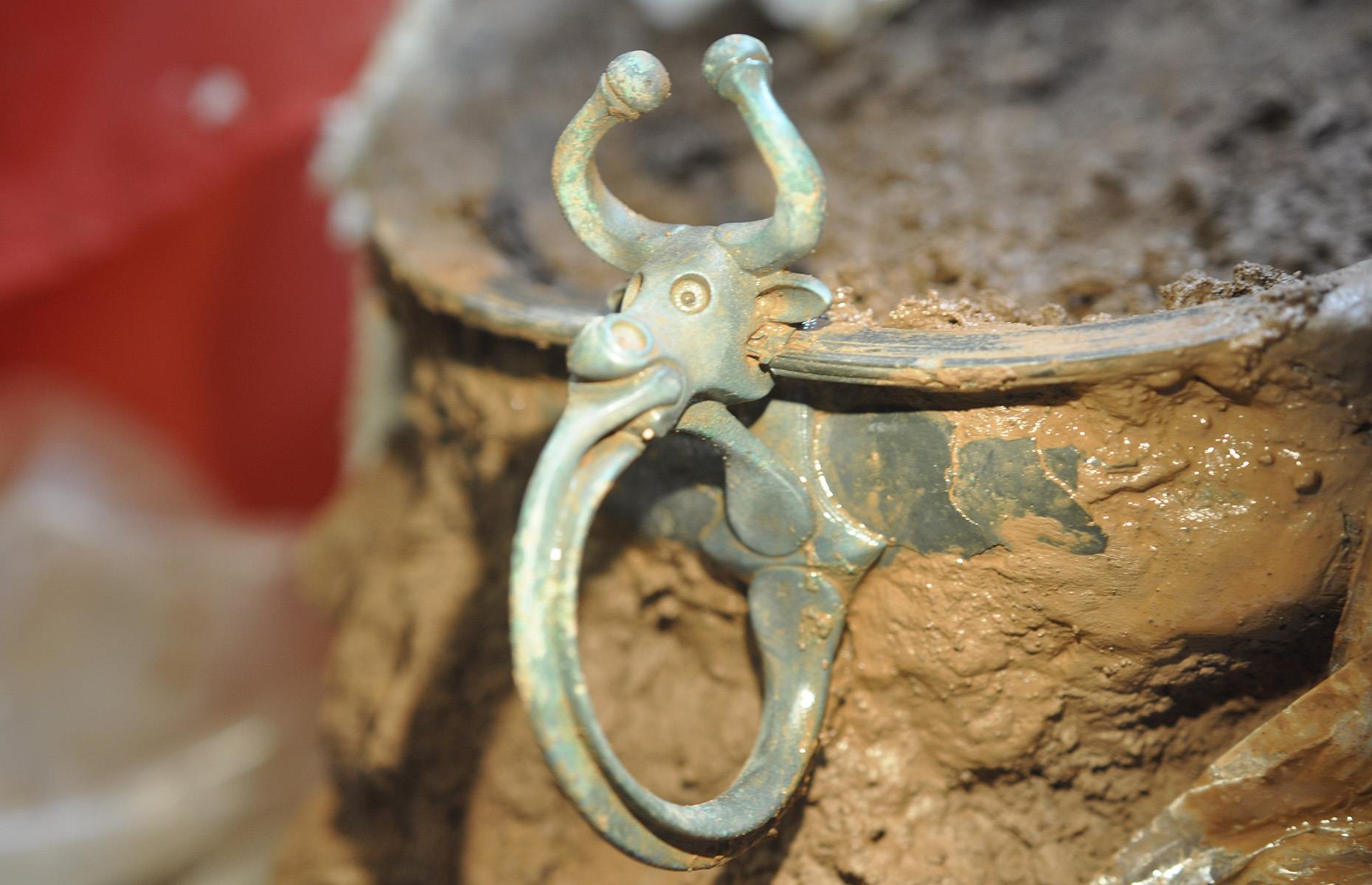
A doe-eyed discovery
When Jon Matthews went metal-detecting in a pasture in Llantrisant Fawr Community in Monmouthshire in 2019, he could hardly have dreamt that he'd stumble across a hoard of buried artefacts dating back to the Roman conquest. Now, in 2023, his finds have been formally declared 'treasure' by local authorities, including two Roman saucepans, two engraved bucket fittings and a bowl affixed with an undeniably cute ox-head handle. Excavating archaeologists promptly nicknamed the ox 'Bovril', according to Dr Adelle Bricking, archaeology curator at National Museum Cardiff. "Imagine our surprise", she tweeted, "when we flicked off the mud and exposed Bovril’s adorable little face."
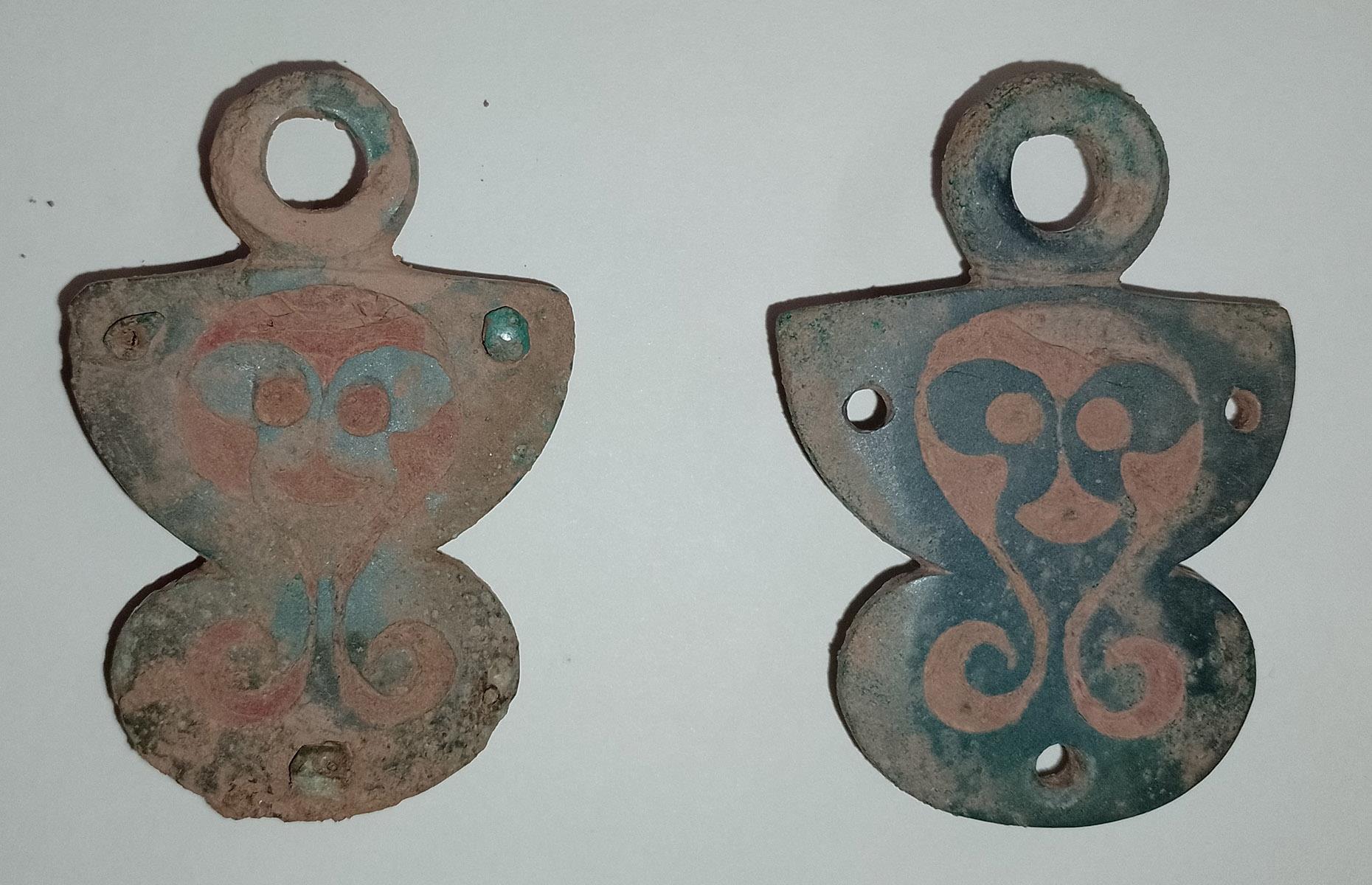
A doe-eyed discovery
The finds date from the second half of the first century AD (Roman emperor Claudius invaded Britain in AD 43), and may well now be acquired by the Welsh national museums following its valuation by the Treasure Valuation Committee. "I feel honoured to have found something so unique that is linked to Wales and our ancestors," commented Matthews. "The archaeologists I excavated the hoard with were a fantastic group of people and through our combined efforts we were able to learn so much from the finds and their placing in the ground."
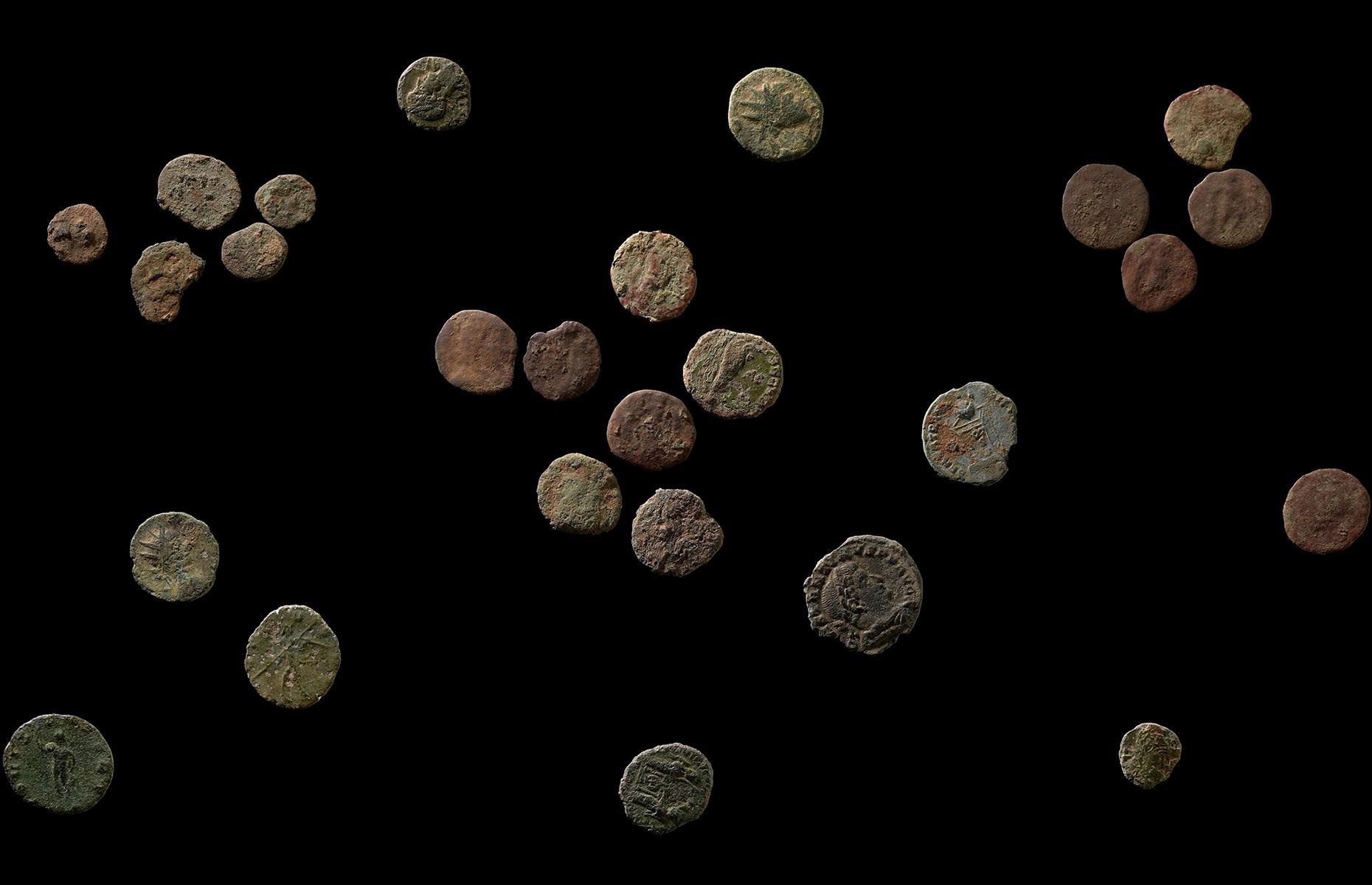
A doe-eyed discovery
Also declared treasure were two Roman coin hoards found nearby between 2014 and 2022. Alastair Willis, senior curator of numismatics at Amgueddfa Cymru – Museum Wales, said that research now suggests "the presence of a previously unknown settlement or religious site" near to where the treasures were found. The copper coins date from the late-third to late-fourth centuries AD – a little-understood period of Welsh history just before the Romans departed Britain in the early fifth century.
Read on for more recent ancient discoveries from around the world, from history's oldest runestone to the so-called Gate of God...
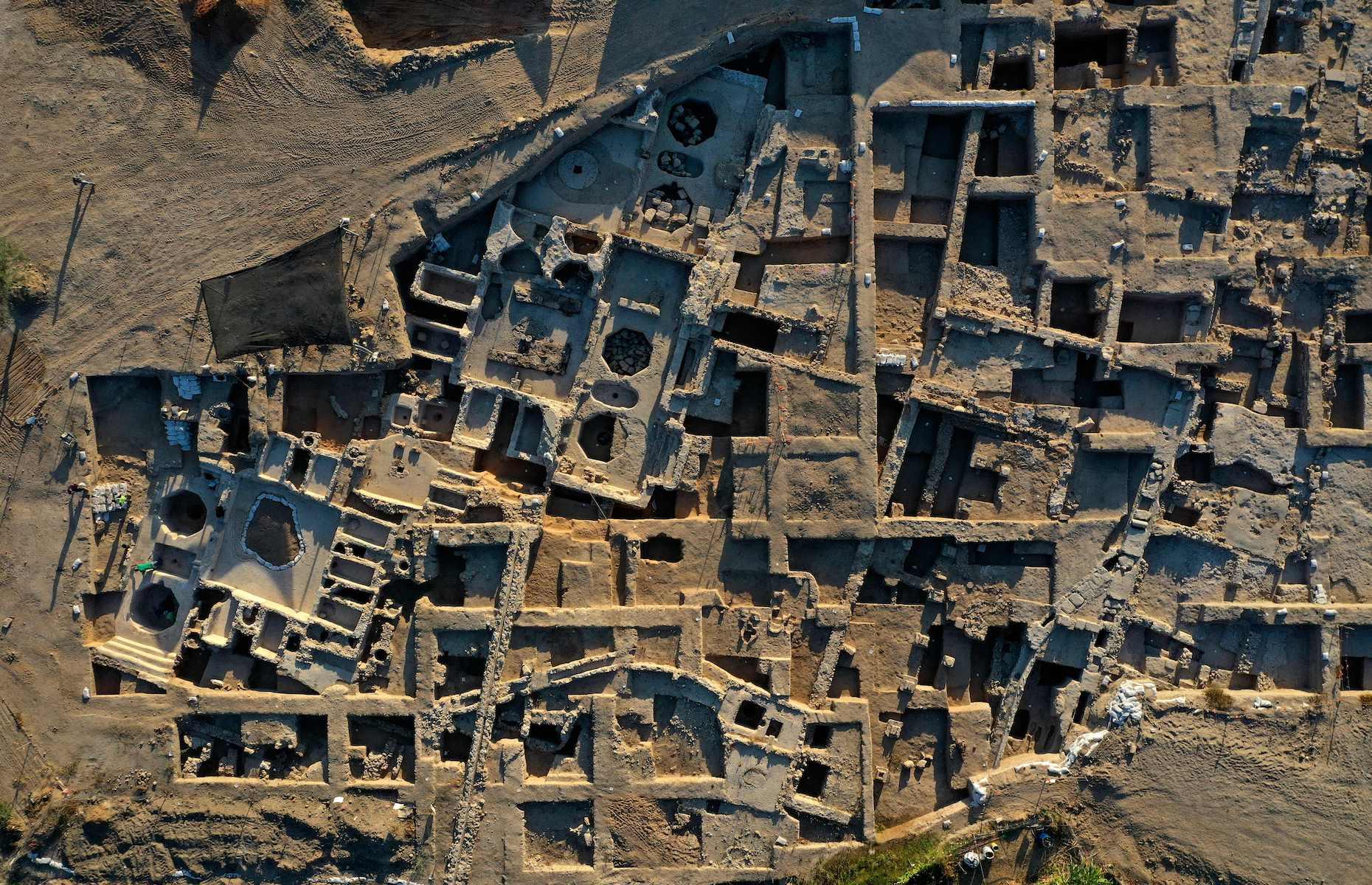
Ancient winery, Israel
Archaeologists working at a dig in Yavne in central Israel made an incredible discovery in October 2021 when they uncovered a 1,500-year-old wine-making complex. Dating back to the Byzantine-era, the sprawling winery consisted of five wine presses and large warehouses. Capable of making two million litres of wine a year, it was likely the largest in the world at the time. The team also unearthed Gaza jars, typically used for wine storage in the region during the Byzantine period, and kilns for firing clay amphorae.
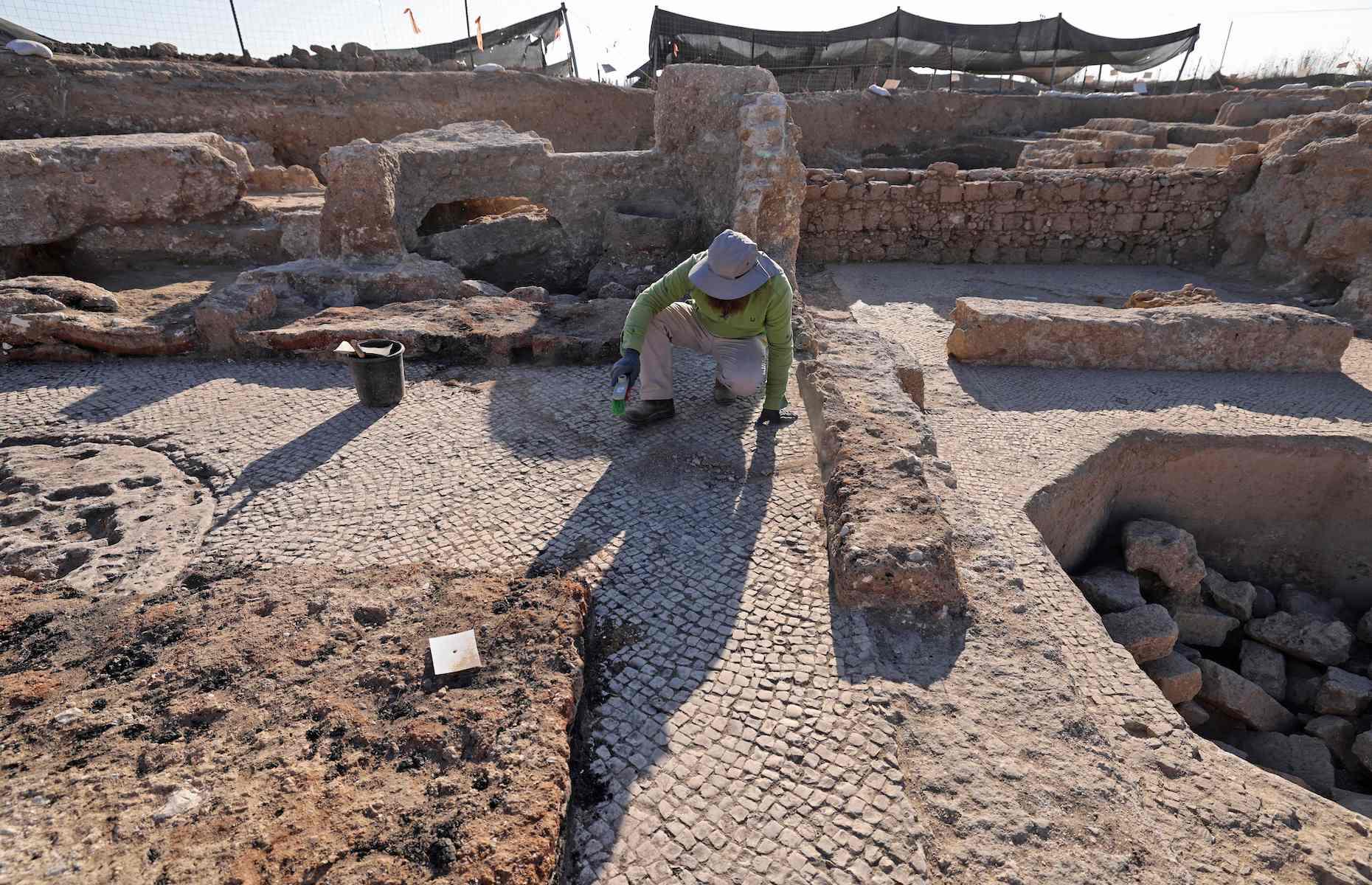
Ancient winery, Israel

Oldest human footprints in North America, New Mexico, USA
Evidence that humans roamed North America between 21,000 and 23,000 years ago has been revealed with the discovery of ancient, fossilised footprints in the White Sands National Park in New Mexico. The new scientific research, conducted by archaeologists and reported in Science in September 2021, found the prints are the oldest impressions ever discovered on the continent. They were found buried in layers of sediment across the ancient Lake Otero and belonged mostly to children and teenagers. It was previously thought that humans arrived in North America between 13,500 and 16,000 years ago.

New species of dinosaur revealed, Chile
In April 2021, Chilean scientists revealed they had uncovered the remains of a new species of dinosaur. The actual finding was made in the 1990s in the Atacama Desert, but after decades of research the team revealed the bones were from a previously unknown species of plant-eating titanosaur, which lived in the region during the Late Cretaceous epoch (between 101 and 66 million years ago). The remains of the long-necked and long-tailed dinosaur are now on display at the Museum of Natural History in Santiago.
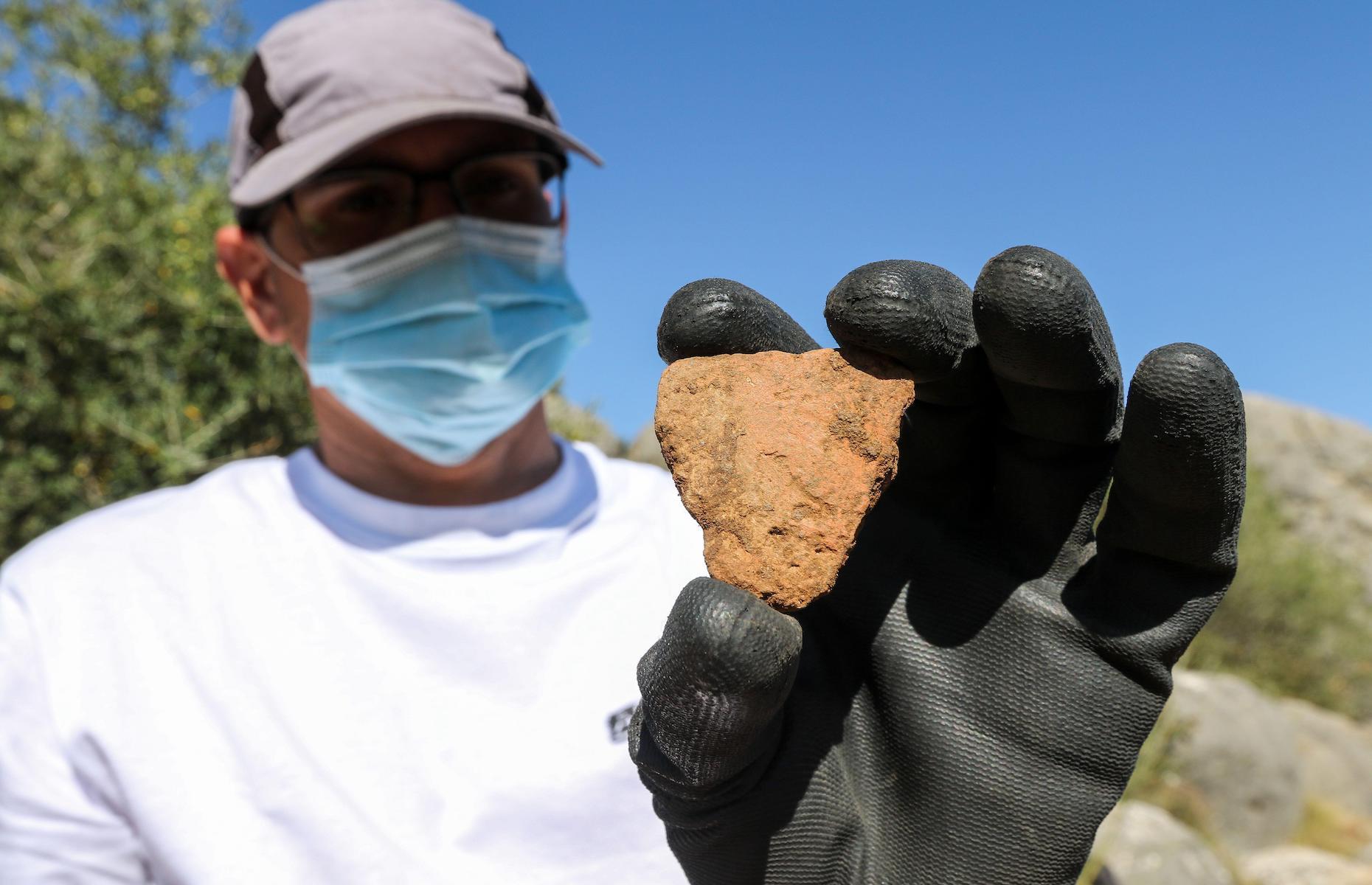
Prehistoric necropolis, Spain
Set by the River Guadalmedina just north of Málaga, the pretty little pueblo blanco (white town) of Casabermeja has a deep-rooted history. There is plenty of evidence of prehistoric settlements in the area, including cave paintings – and, in 2021, even more ancient relics were revealed. Forensic scientists confirmed human remains found by a member of the public were evidence of a 5,000-year-old necropolis.
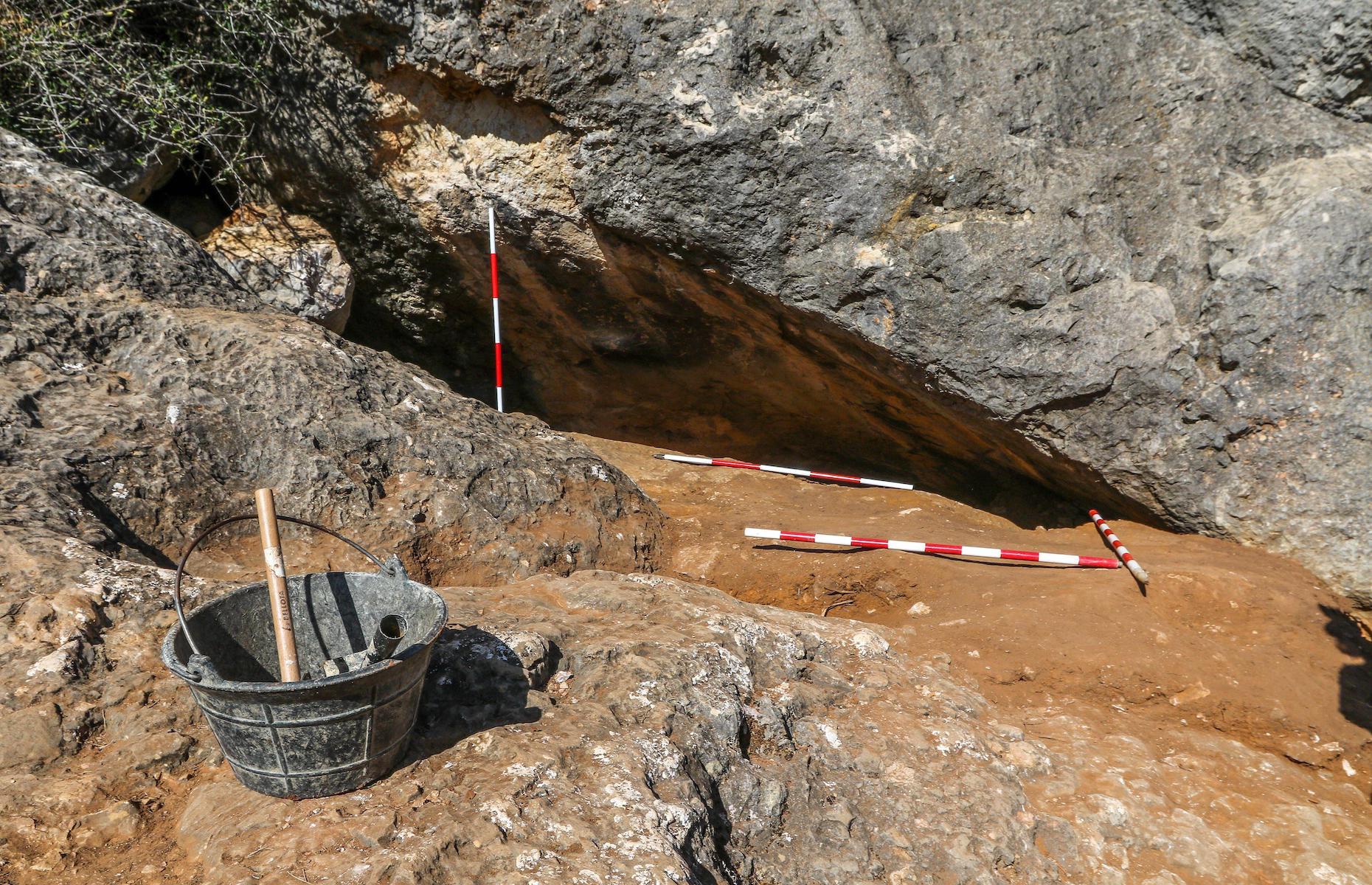
Pre-historic necropolis, Spain
Located in an area of Casabermeja called Piedras de Mitra, the skeletal remains date from the period between the Neolithic and Chalcolithic (or Copper) ages. So far, archaeological excavations have revealed five burial sites housed within small caves, complete with funereal relics.
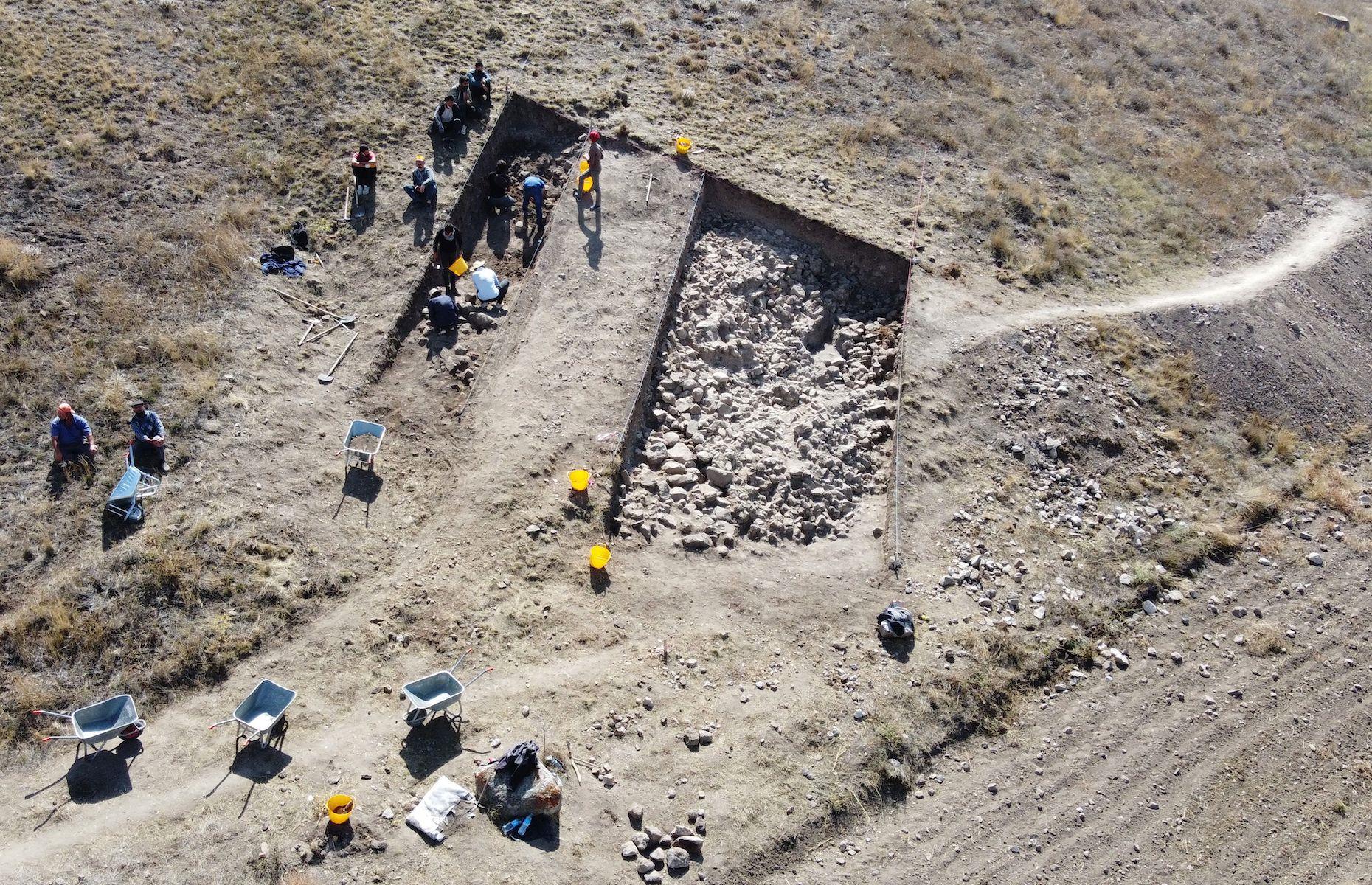
Hittite mosaics, Turkey
Turkish archaeologists uncovered floors that have been described as the “ancestor” of Mediterranean mosaics in Usakli Hoyuk, an archaeological site in Yozgat’s Sorgun district. In September 2021, the 3,500-year-old paving stones were found in the remnants of a 15th-century BC temple dedicated to Teshub, a storm deity worshipped by the Hittites. It marks a huge step towards understanding more about the daily life of the little-understood Bronze Age Anatolian civilisation.
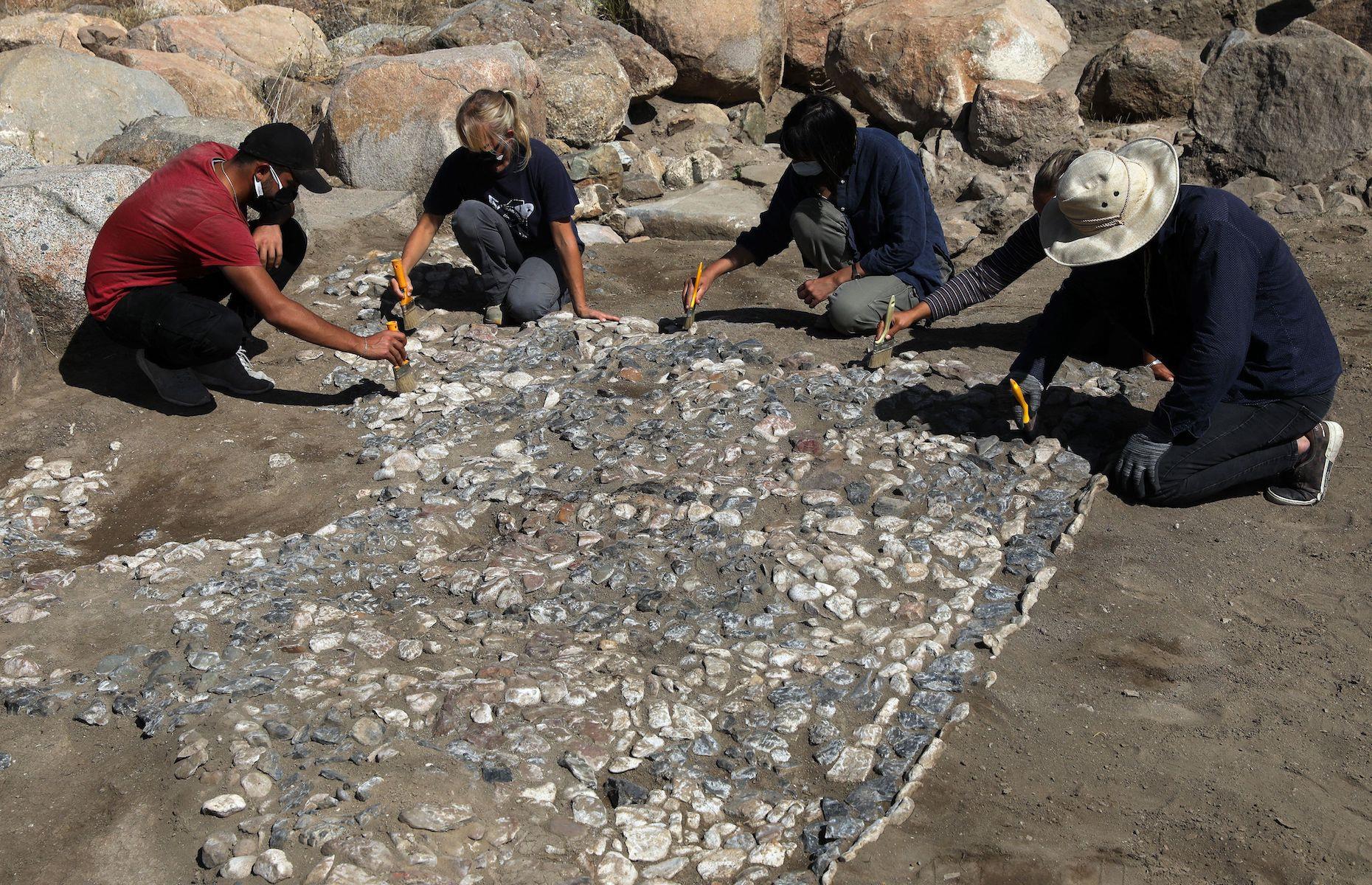
Hittite mosaics, Turkey
Thousands of small natural-coloured stones in shades of beige, red and black were revealed using shovels and brushes, and they were found to be arranged in simple geometric patterns of triangles and curves. The extraordinary find goes back 700 years before the oldest known mosaics of ancient Greece were made. Excavations at Usakli Hoyuk began in 2008 and it’s thought the site could be the "lost" ancient Hittite centre of Zippalanda.
Love this? Follow our Facebook page for more inspirational stories about our planet
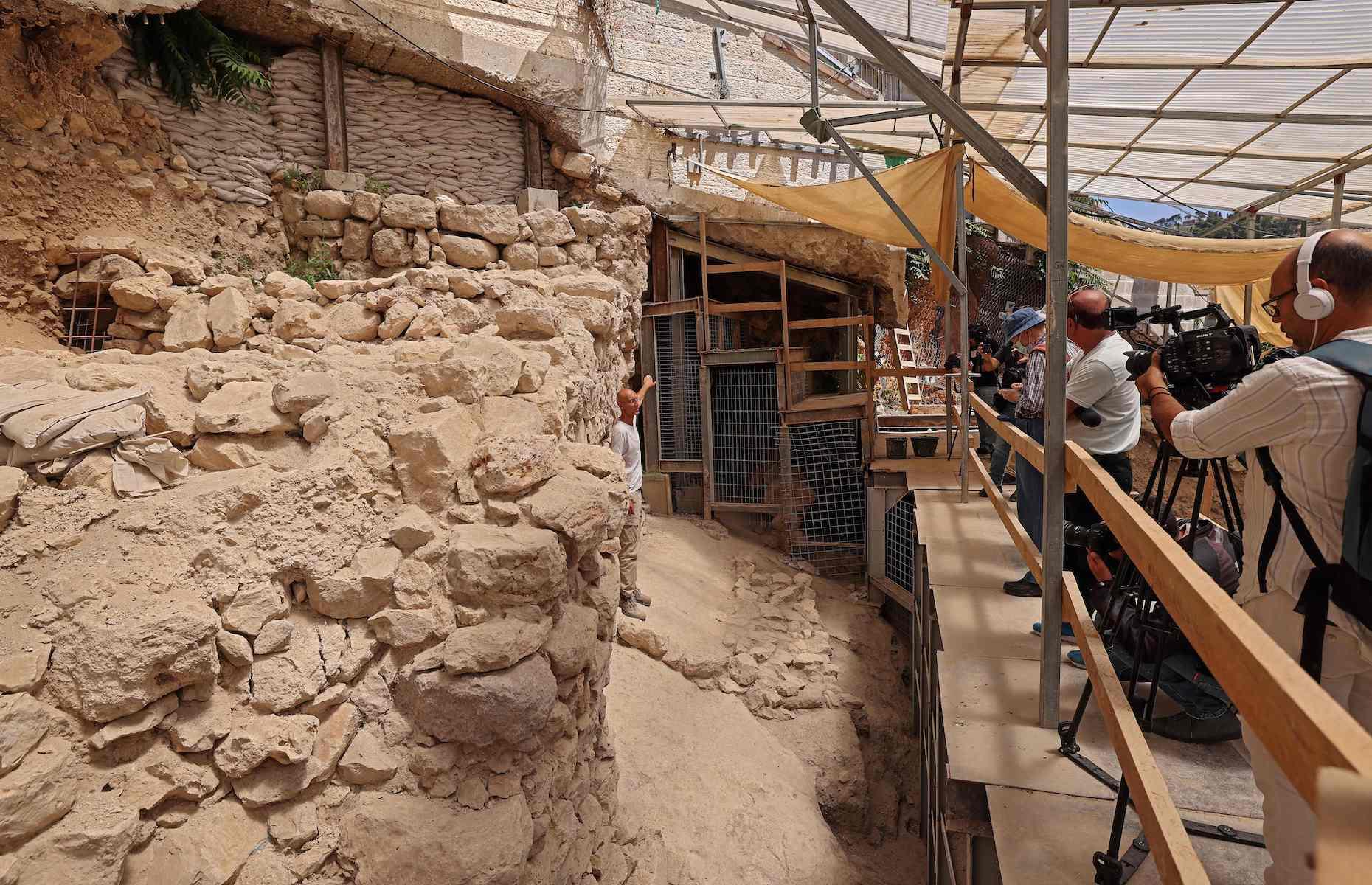
City wall of Jerusalem, Israel
Israel Antiquities Authority archaeologists working at the City of David National Park in the Old City of Jerusalem discovered what they believe is a missing section of Jerusalem’s outer city wall, part of the original Iron Age fortifications that were built at least 2,700 years ago. Most of the wall would have been destroyed during a Babylonian invasion in 586 BC, which saw Nebuchadnezzar II plunder the city.
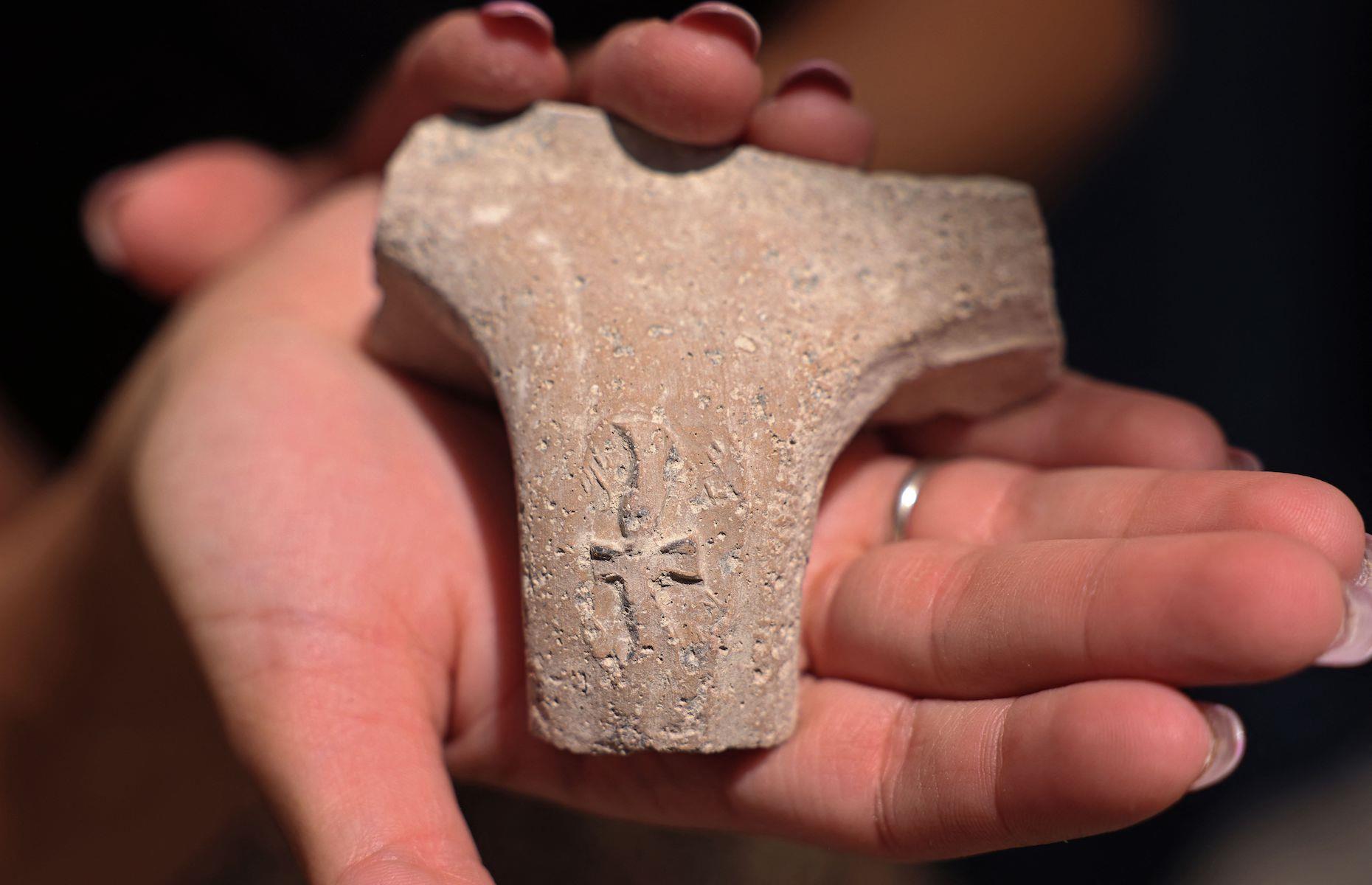
City wall of Jerusalem, Israel
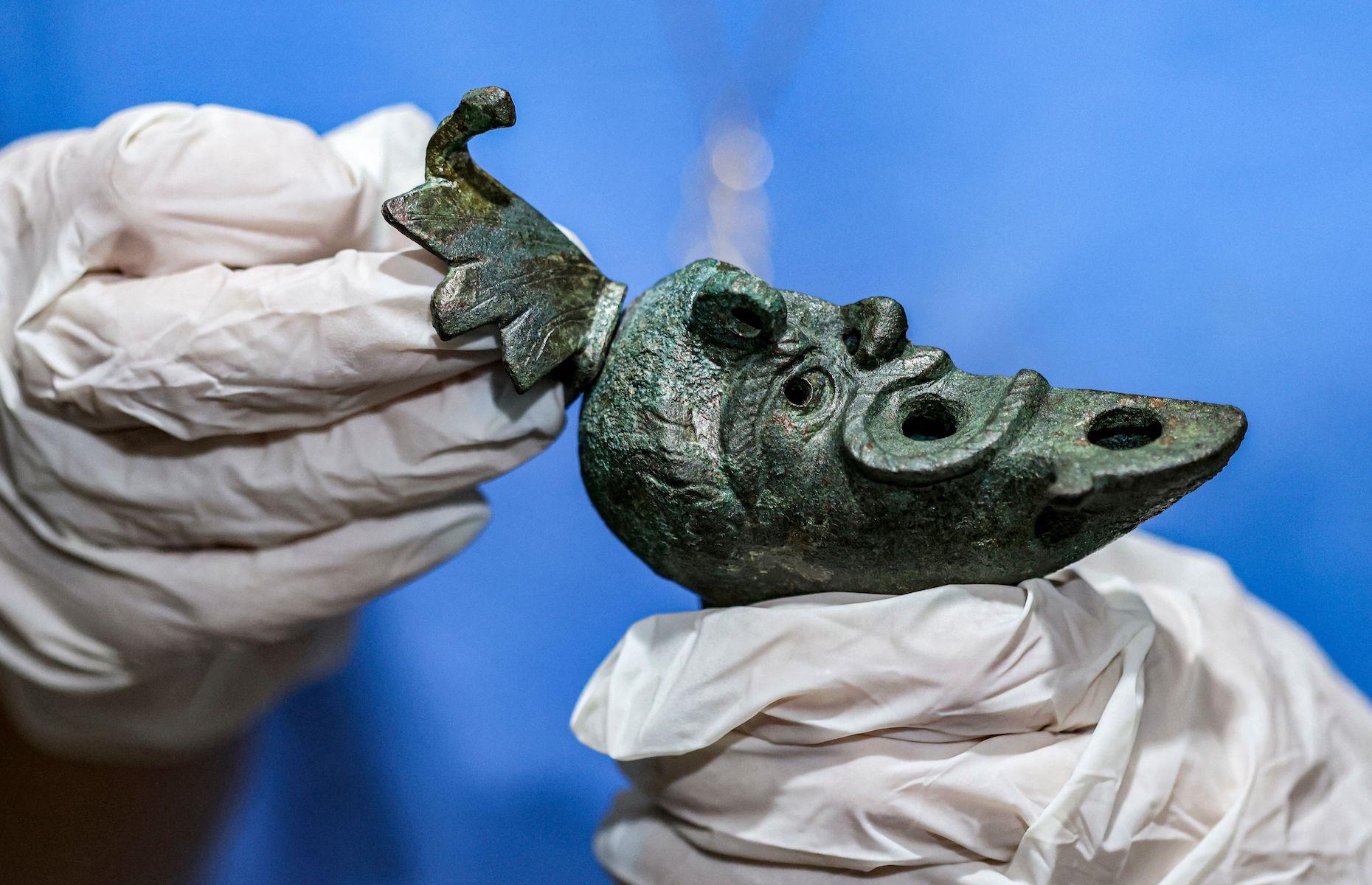
Bronze oil lamp, Israel
In May 2021, a rare and bizarre-looking bronze oil lamp was discovered by Israeli archaeologists in the foundation of a building erected in Jerusalem’s City of David almost 2,000 years ago. The Israel Antiquities Authority said it believed the lamp, which is shaped like half a head of a bearded man, was deposited as an offering to bring good fortune to the building’s residents. It’s estimated to be from the late 1st century or early 2nd century. The lamp’s unusually well-preserved wick was also discovered at the excavation site.
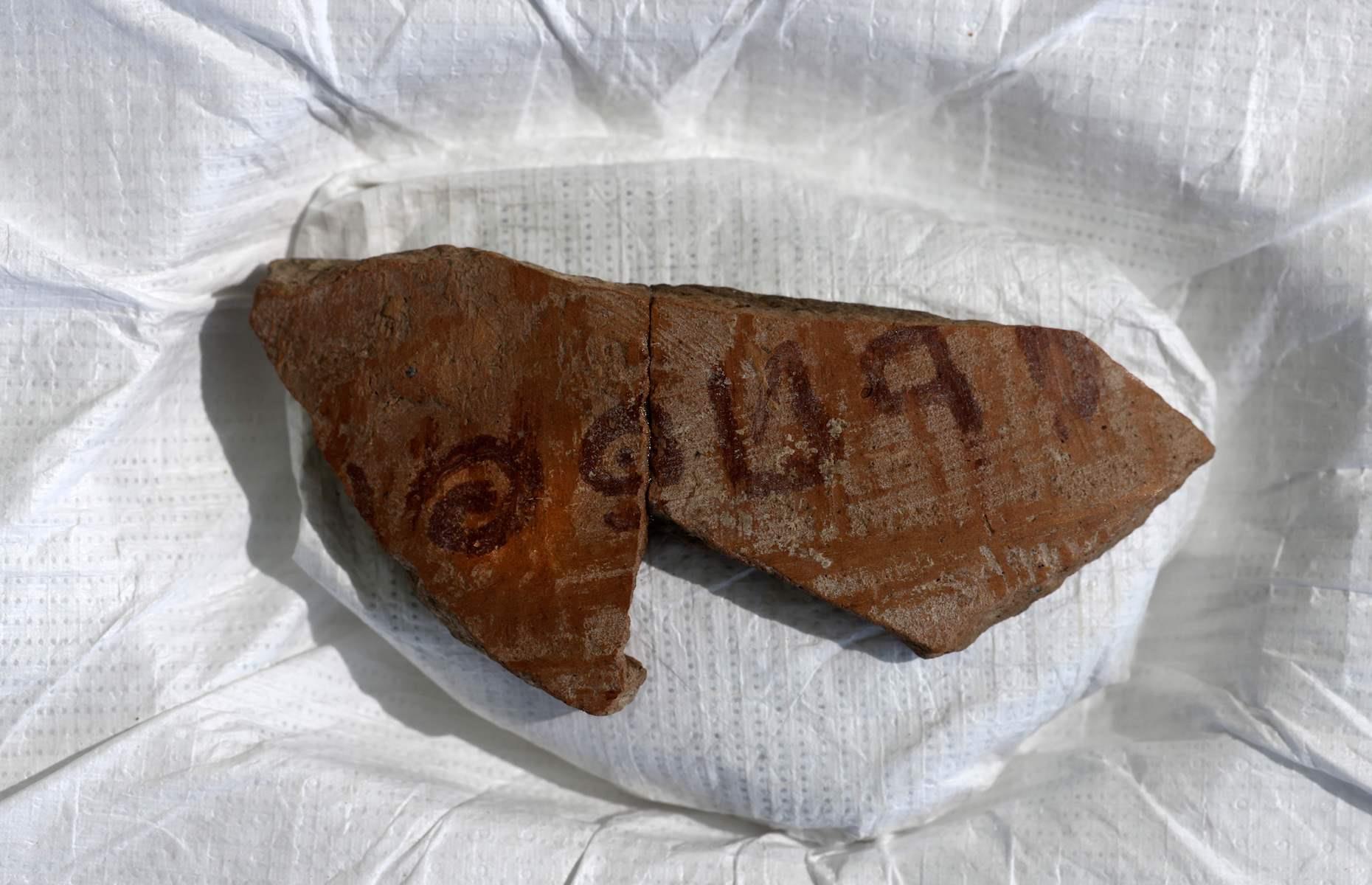
Rare inscription from the biblical period, Israel
Also in Israel, a biblical-era inscription written in ink on a pottery vessel in Canaanite alphabetic script was found inside a storage pit at Khirbet er-Ra‘I archaeological site in July 2021. Bearing the name of the biblical judge Jerubbaal, it dates from around 1,100 BC and is the first time his name has been found at an archaeological site. The fragment is from a small jug that most likely carried precious liquids such as scented oil. Inscriptions from the biblical period are extremely rare.
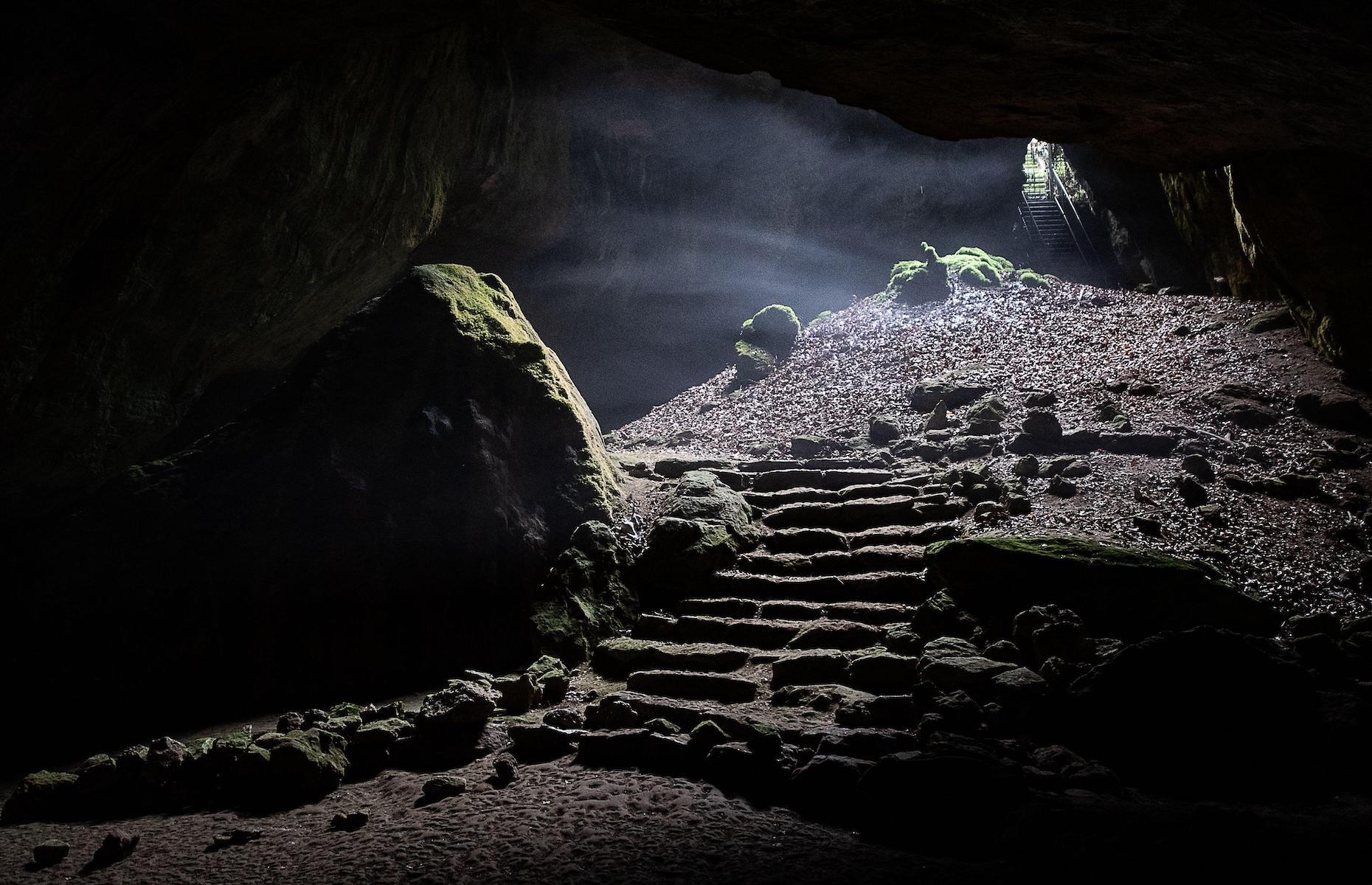
Neanderthal carving, Germany
Further evidence that Neanderthals (Homo neanderthalensis) were also capable of artistic or symbolic expression – once qualities only attributed to Homo sapiens – was uncovered in July 2021. The toe bone of a prehistoric deer, carved with geometric lines by Neanderthals 51,000 years ago, was discovered in Einhornhöhle, or the Unicorn Cave, in Germany's Harz Mountains (pictured). It is one of the oldest works of art ever found. Also located near the carving were the shoulder blade bones of deer and the intact skull of a cave bear.
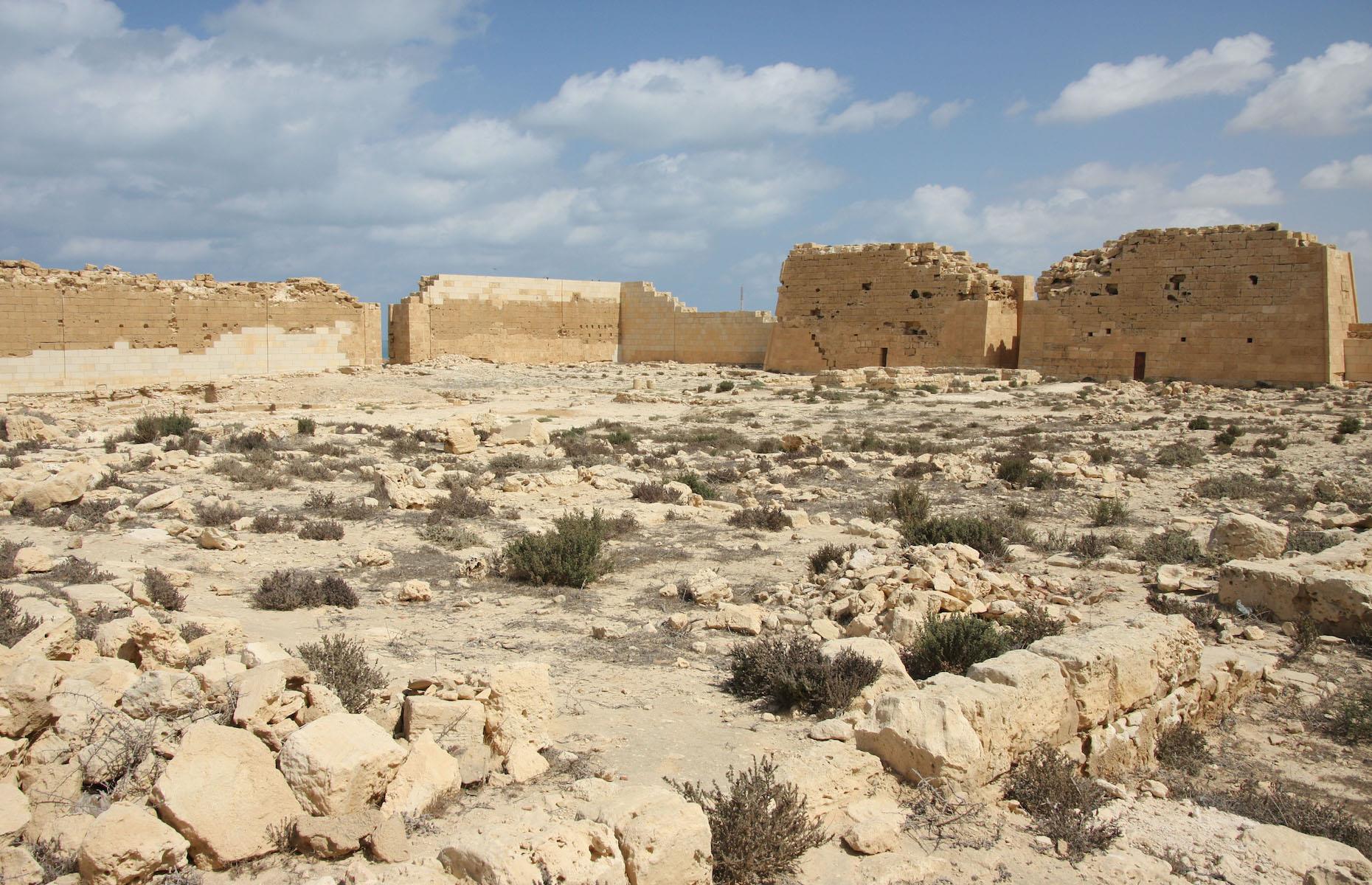
Golden-tongued mummies, Egypt
In the stuff of treasure hunters’ dreams, archaeologists working at a burial site at the Taposiris Magna Temple (pictured) near Alexandria unearthed ancient mummies with golden tongues, in February 2021. The 2,000-year-old mummies were discovered in 16 burial shafts dating from the Greek and Roman era. Amulets of gold foil, shaped in the form of a tongue, were apparently placed in the mouths of the dead to help them speak to the court of Osiris in the afterlife. A woman’s funeral mask was also found.
Now check out the world's amazing lost cities that we've only just discovered
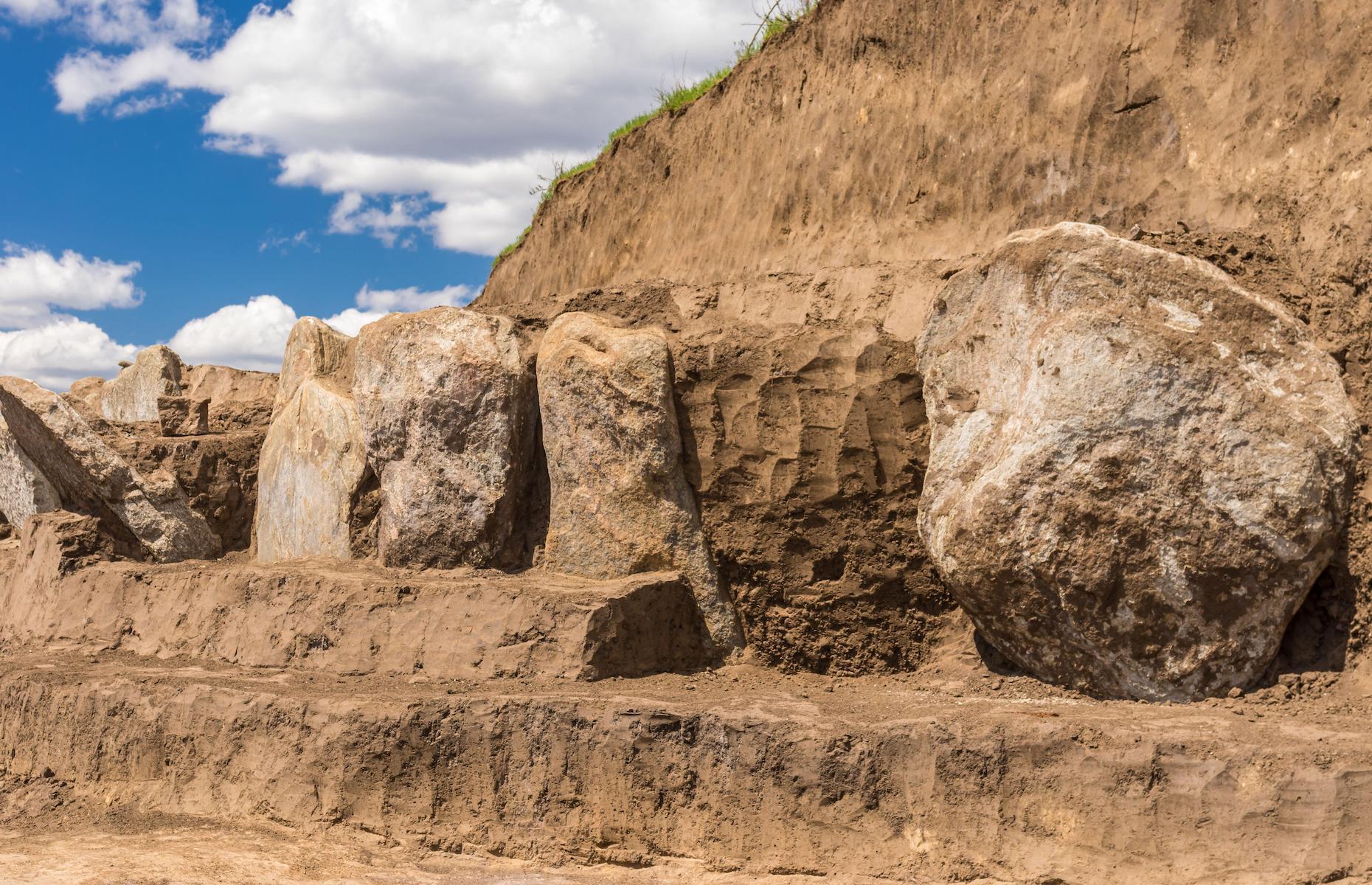
Bronze Age burial mound, Ukraine
Excavations of a kurgan (burial mound) in eastern Ukraine revealed multi-layered graves from the early Bronze Age, Scythian era and the Middle Ages. The macabre discovery was made during road works in the village of Novooleksandrivka in July 2021. A stone structure, known as a cromlech, was found in the inner part of the ancient mound, created by tall vertical blocks placed in a circle. The mound, thought to be around 5,300-5,500 years old, contained 27 skeletons. One corpse showed traces of mummification while others were accompanied by artefacts such as wolf-fang necklaces and flint tools.
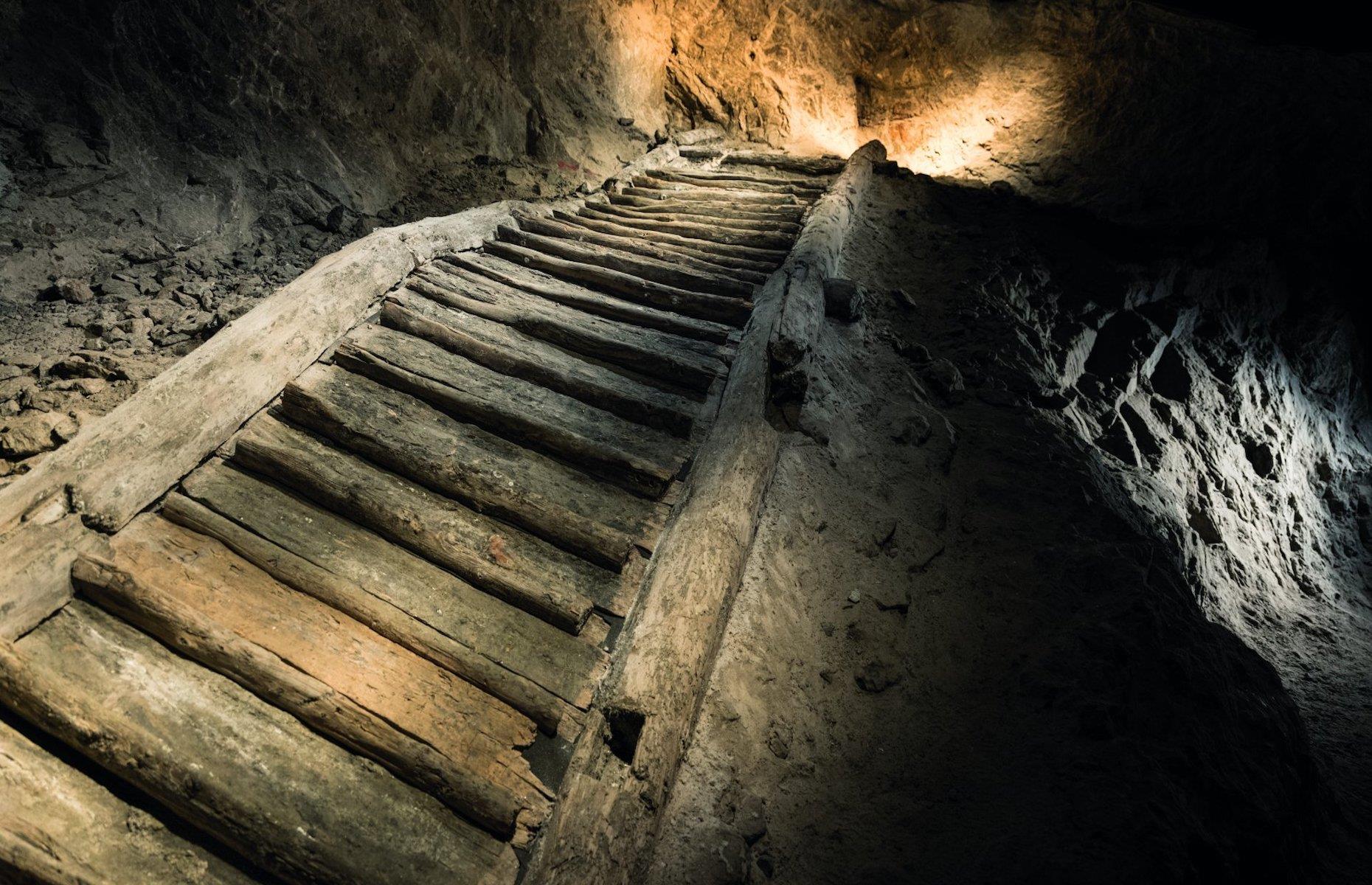
Ancient faeces, Austria
In October 2021, paleofaeces discovered in the Hallstatt-Dachstein/Salzkammergut salt mines (pictured) in the Austrian Alps revealed surprising findings about the diets and food techniques employed by ancient people. The fossil samples were analysed by experts and found to contain two fungi associated with fermentation techniques. It showed that blue cheese and beer were both made and enjoyed in Europe during the Iron Age. The ancient excrements were left behind by prehistoric miners at the mine, now part of a UNESCO World Heritage Site, which has been used for salt production for more than 3,000 years.
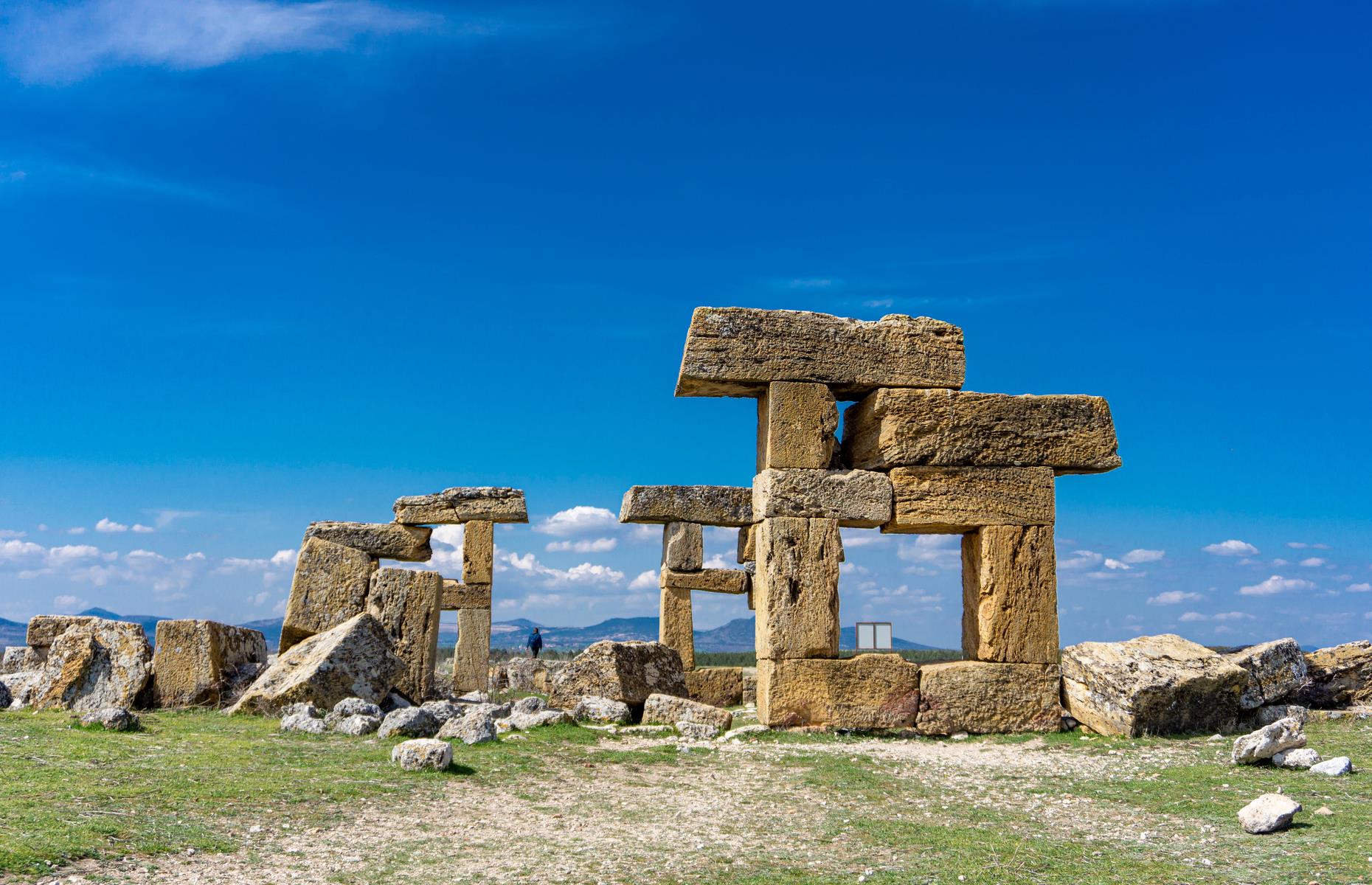
Rock-cut necropolis, Turkey
An extraordinary and extensive network of rock-cut chamber tombs was uncovered in October 2021 by archaeologists working at the ancient city of Blaundos near Uşak in Turkey. The team found 400 tombs that had been cut into the steep side of a canyon around 1,800 years ago. Many of them have multiple remains and feature intricate wall paintings, detailing vines, flowers, mythological figures and geometric patterns, as well as pottery and artefacts. Founded at the time of Alexander the Great, the ancient centre of Blaundos later became an important Roman city in Asia Minor.
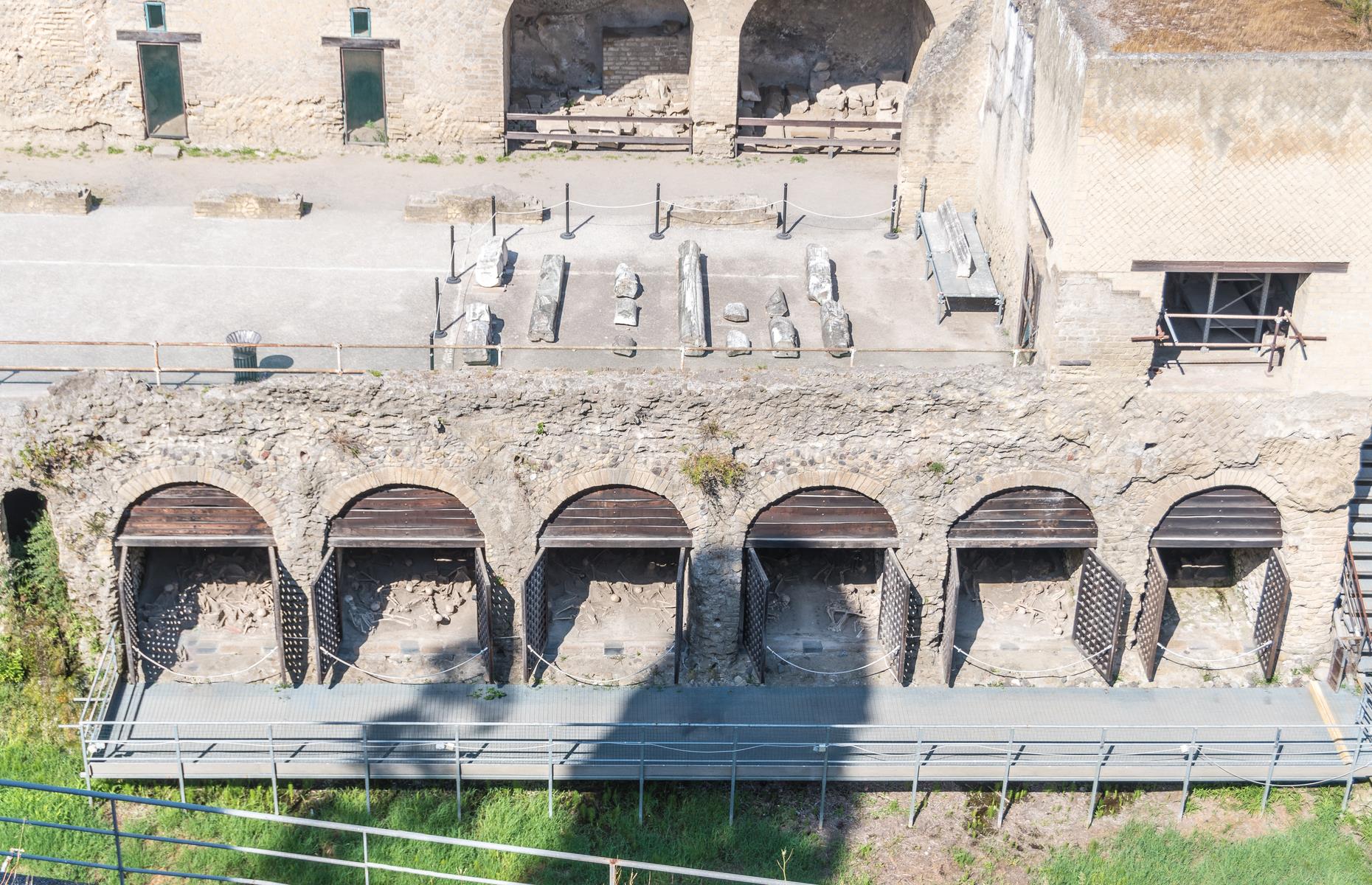
Skeleton at Herculaneum, Italy
Fascinating discoveries were made at the ancient Roman town of Herculaneum, near Pompeii, in October 2021, during the first archaeological dig on the site in almost three decades. The remains of a man were found just steps from what would have been the ancient town’s beach (pictured). The mud-encased skeleton was surrounded by carbonised wood, including a roof beam that may well have collapsed on him as he tried to escape the catastrophic eruption of Mount Vesuvius in AD 79.
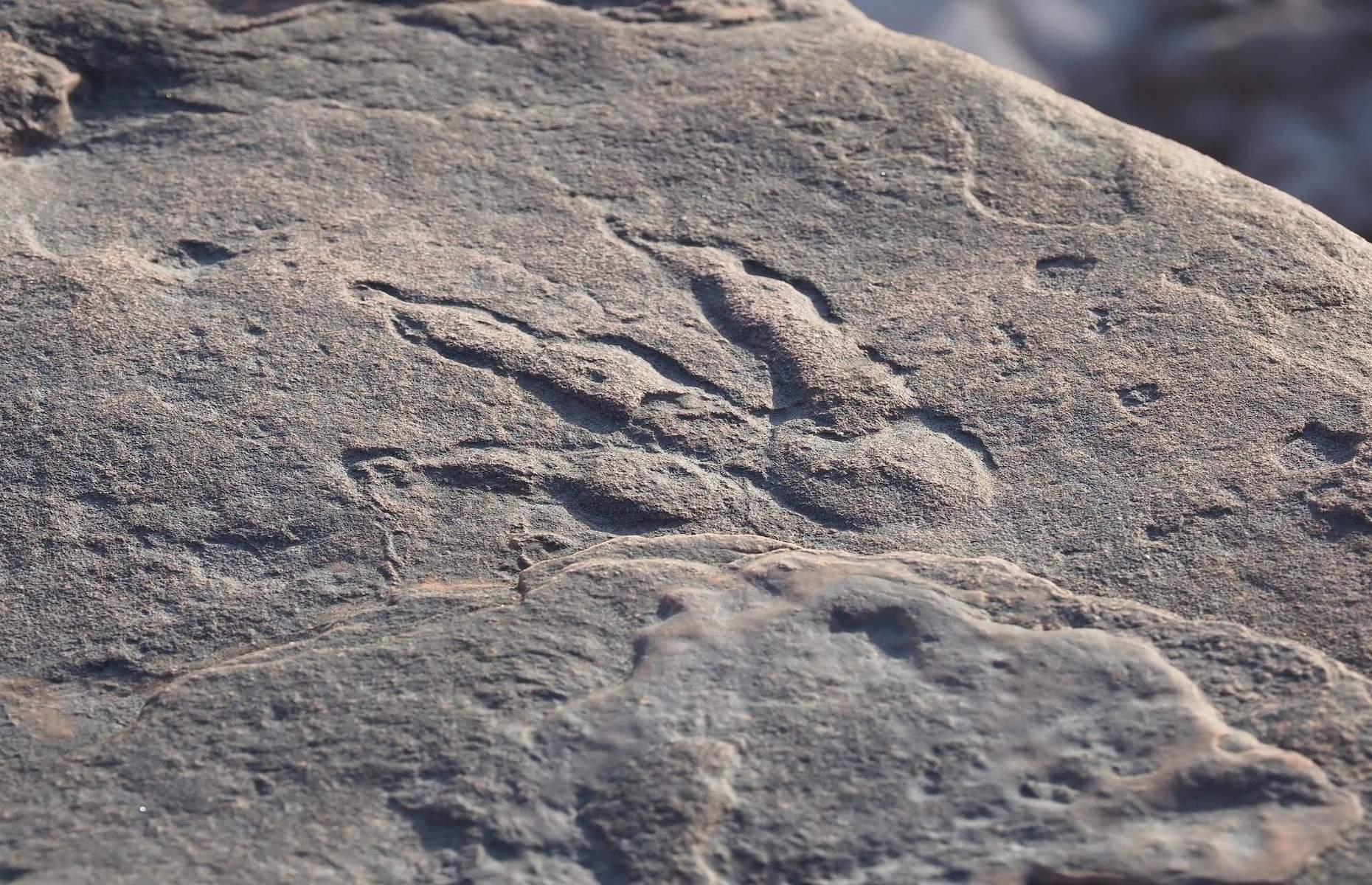
Dinosaur footprint, Wales, UK
A seaside stroll turned into the discovery of a lifetime for one little girl in January 2021. While walking on Bendricks Bay near Barry in south Wales with her father, four-year-old Lily Wilder noticed an unusual imprint on a rock. They photographed it and sent it off to the experts. Now identified as a 220-million-year-old footprint of an unidentified herbivorous dinosaur that had been preserved in mud, the fossil was extracted from the site of special scientific interest and taken to National Museum Cardiff where it is now on display.

Boundary stone, Rome, Italy
A rare find was uncovered during excavations for the redevelopment of a piazza in Rome in August 2021 – a large marble boundary stone, known as a pomerium cippus, which marked the sacred limits of the Roman Empire's capital. The inscription places it in AD 49, the time of Emperor Claudius who carried out the enlargement of the pomerium, the sacred part of the city. It would have been laid to mark the new boundary between the historic city and its conquered territory. It's the first discovery of its kind in more than 100 years.
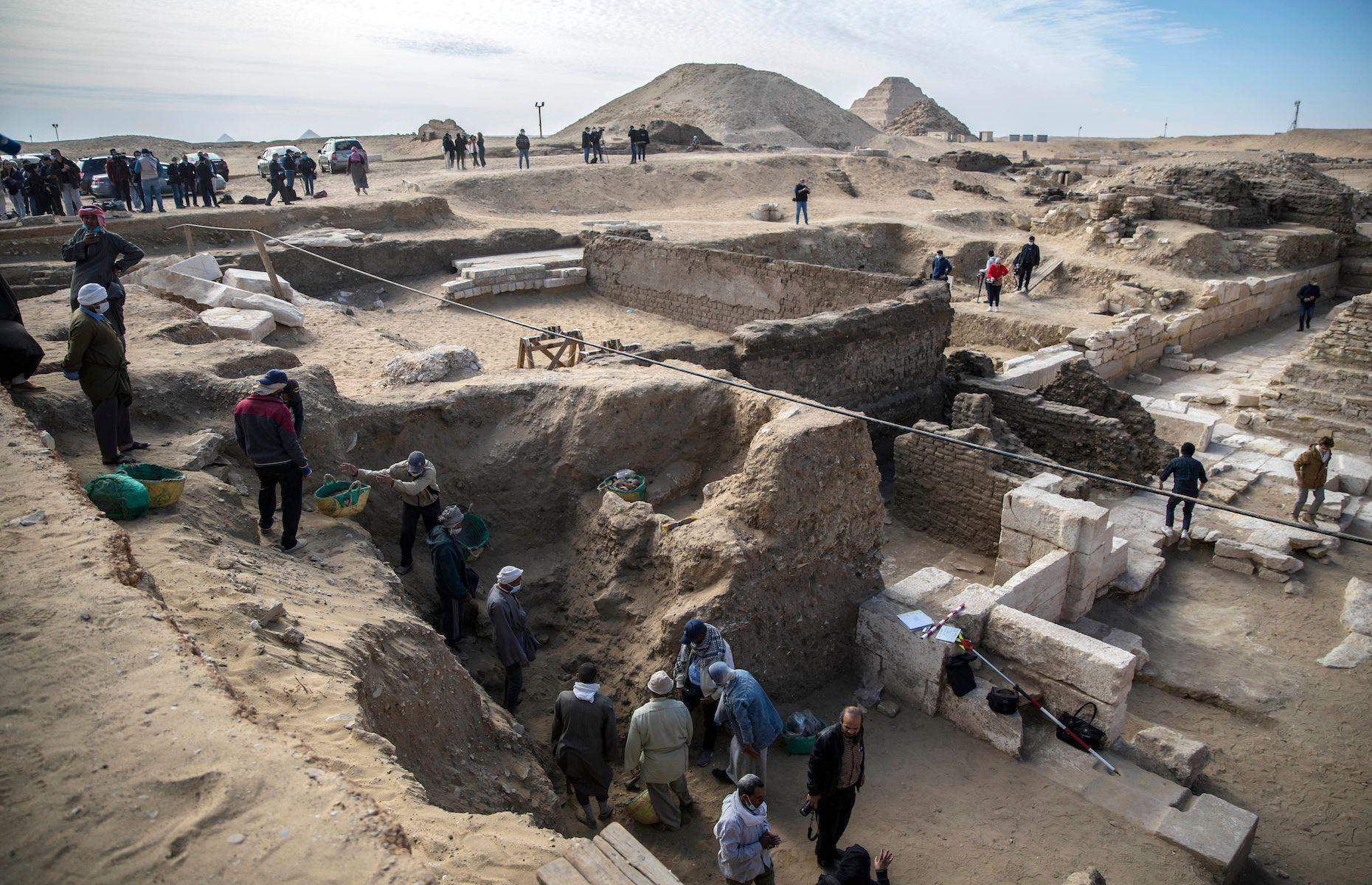
Queen’s funerary temple, Saqqara, Egypt
A series of significant new discoveries were made at Saqqara, a vast ancient burial ground south of Cairo known for its stepped pyramid, in January 2021. Archaeologists unearthed the funerary temple of Queen Nearit, a previously unknown wife of King Teti, the first pharaoh of the Sixth Dynasty who ruled between 2323 BC and 2150 BC.
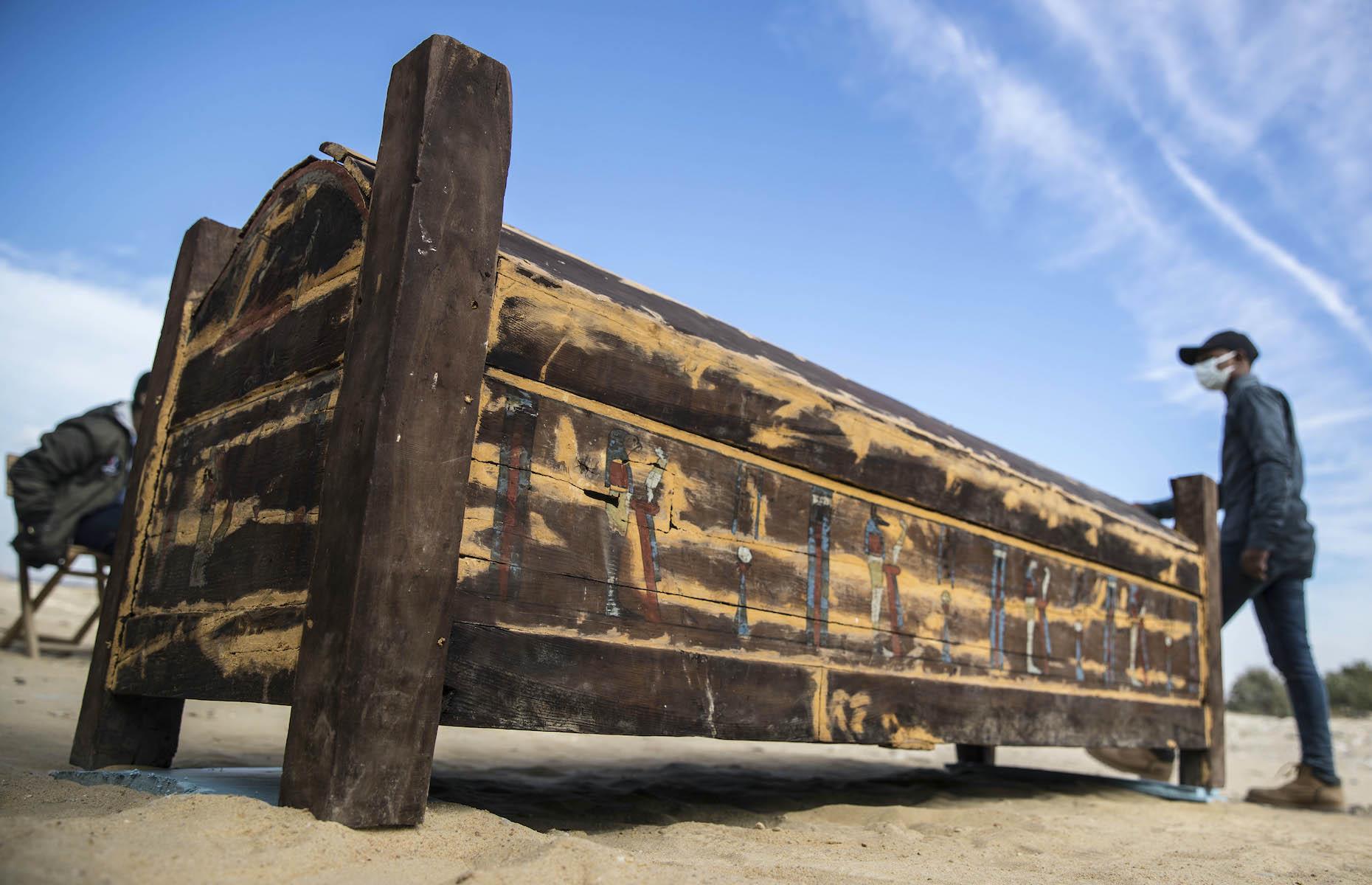
Wooden coffins, Saqqara, Egypt
Part of the burial grounds for the ancient capital, Memphis, Saqqara also yielded more secrets as burial shafts, coffins and mummies dating back to nearly 3,000 years ago have been excavated. One of the most dazzling discoveries was a series of ornately painted wooden coffins, some with mummies and artefacts, including amulets, funeral statues and masks. Pictured here is one of the coffins being revealed to the public in January 2021.
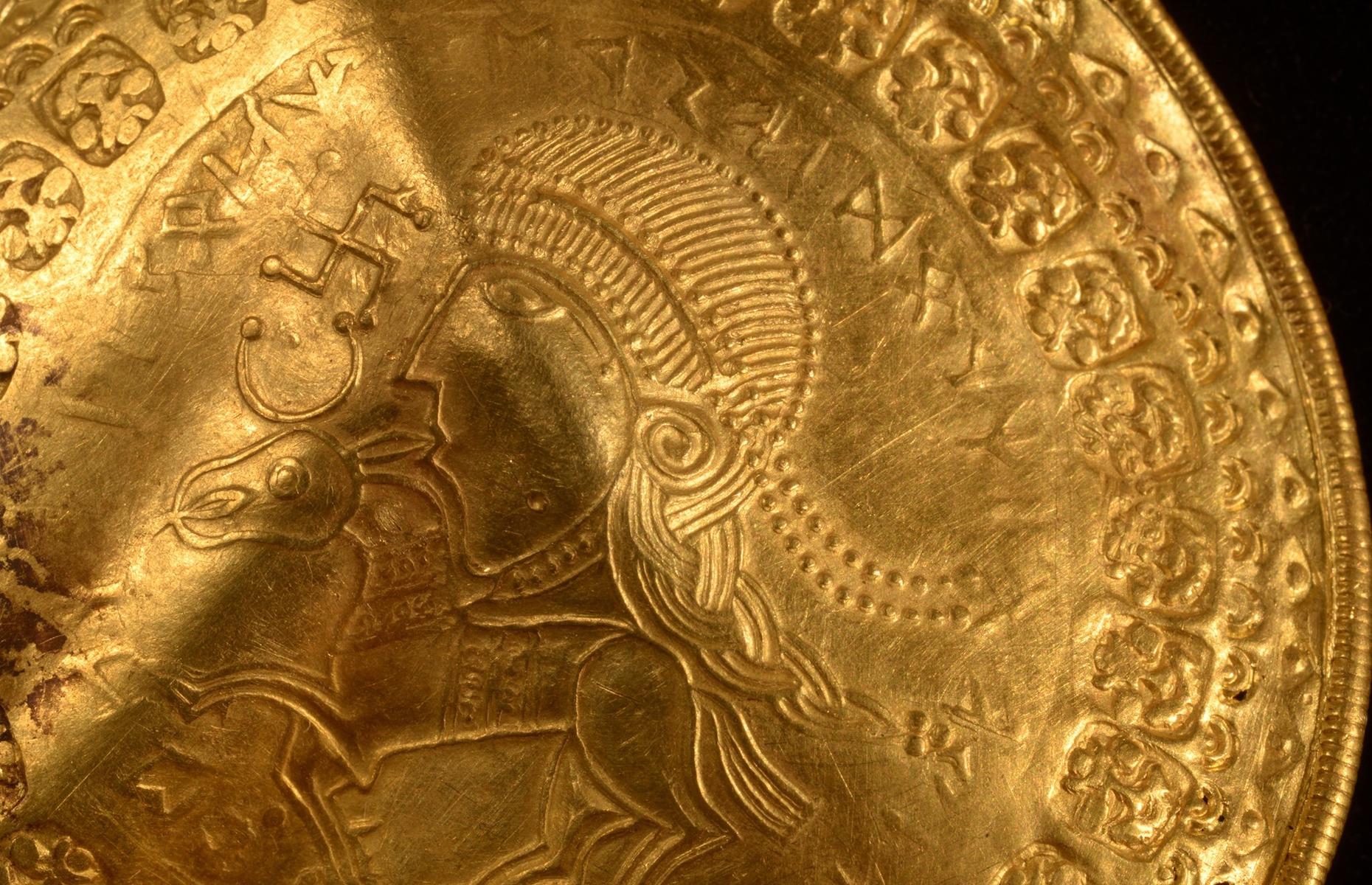
Iron Age golden treasure, Denmark
In an extraordinary case of beginner’s luck, first-time detectorist Ole Ginnerup Schytz discovered a hoard of Iron Age golden treasure just hours after he started investigating a field in Vindelev, near Jelling, in September 2021. The treasure, which contained huge gold medallions, coins and jewellery, has since been dated back to the mid-sixth century and was likely buried by an Iron Age chieftain under a longhouse. The Vejle Museum in Jutland, which worked on the excavation, described it as “one of the largest, richest and most beautiful gold treasures in Danish history so far”.
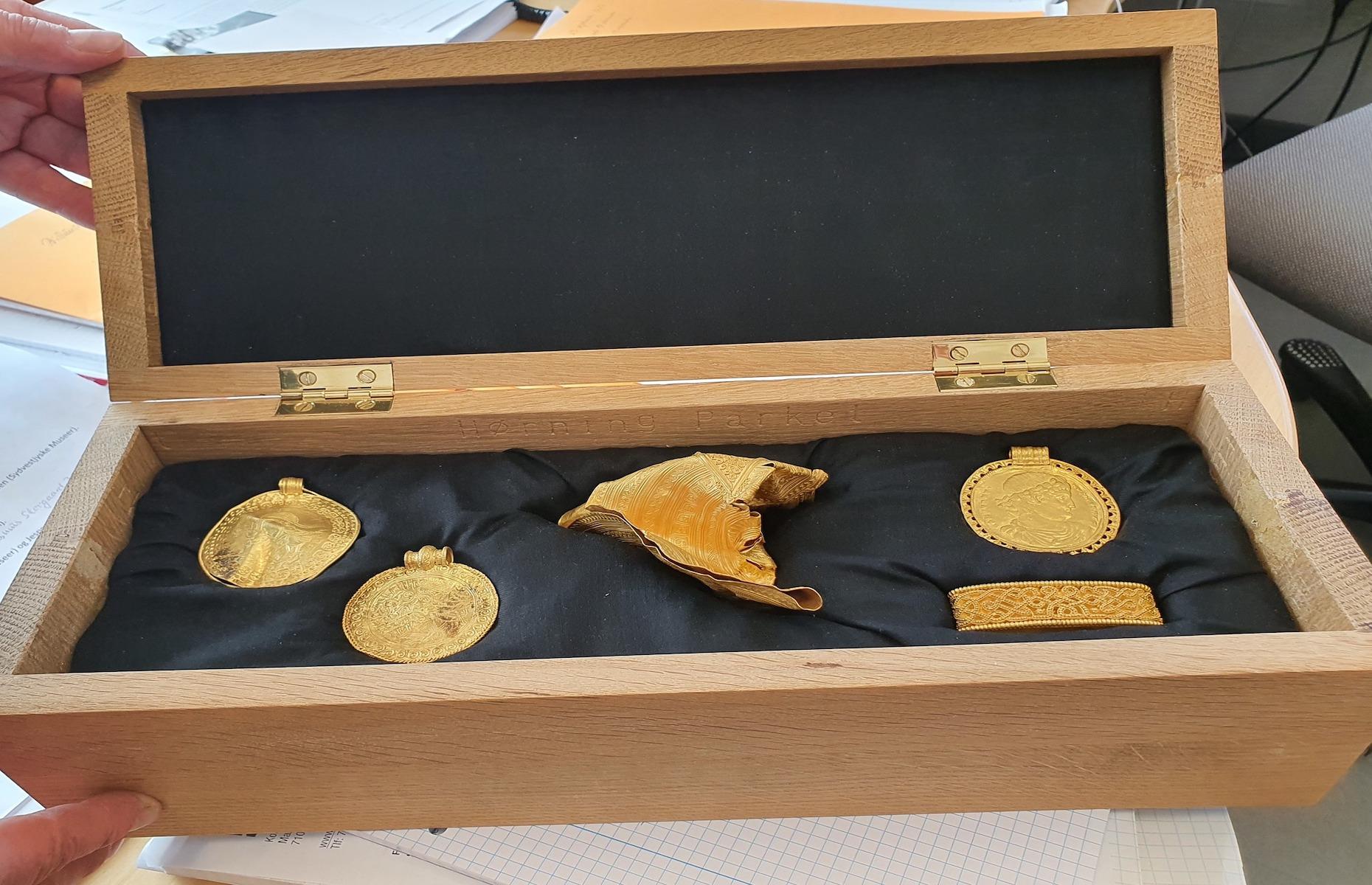
Iron Age golden treasure, Denmark
Now known as the Vindelev Hoard, the incredible haul weighed almost one kilogram (2.2lbs) – an enormous hoard that shows Vindelev was a powerful centre in the late Iron Age. Quite why it was buried remains a mystery, but experts at the Vejle Museum suggest it was perhaps to keep it safe in case of war or as a sacrifice to gods. Among the treasure was a much older coin from the Roman Empire, at the time of Emperor Constantine the Great (AD circa 285–337), suggesting countries were closely connected through both trade and war. The hoard went on display at the museum in February 2022.

Rise of Aten, Egypt
Thought to be the most significant archaeological find in Egypt in the past century, a 3,000-year-old city known as Rise of Aten was uncovered under the sands near Luxor in April 2021. Described by Egyptologist Zahi Hawass as a “Lost Golden City”, it is the largest ancient city ever found in Egypt and it dates to the reign of Amenhotep III. The pharaoh ruled in the 1300s BC, during an era renowned for its wealth and power.

Rise of Aten, Egypt
The excavations, which began in September 2020, uncovered the well-preserved mud-brick structures of a sprawling royal city. A bakery and various residential and industrial districts have so far been identified. Among the rooms were an abundance of significant objects, including jewellery, pottery and mud bricks bearing the seals of Amenhotep III. One especially intriguing find was a vessel filled with what archaeologists believe is boiled or dried meat.
Inside Egypt's "Lost Golden City" that's only recently been discovered

Roman mosaic, Rutland, England, UK
Many people relished opportunities for outdoor exercise during lockdown in 2020 – but few were lucky enough to stumble across historic treasures. That’s exactly what happened to Jim Irvine, who was strolling across land owned by his father Brian Naylor in Rutland, when he discovered pieces of pottery and clay tiles on the ground. After getting in touch with a local museum and realising he had found a historic artefact, the job of excavating the site was handed over to archaeologists from the University of Leicester.
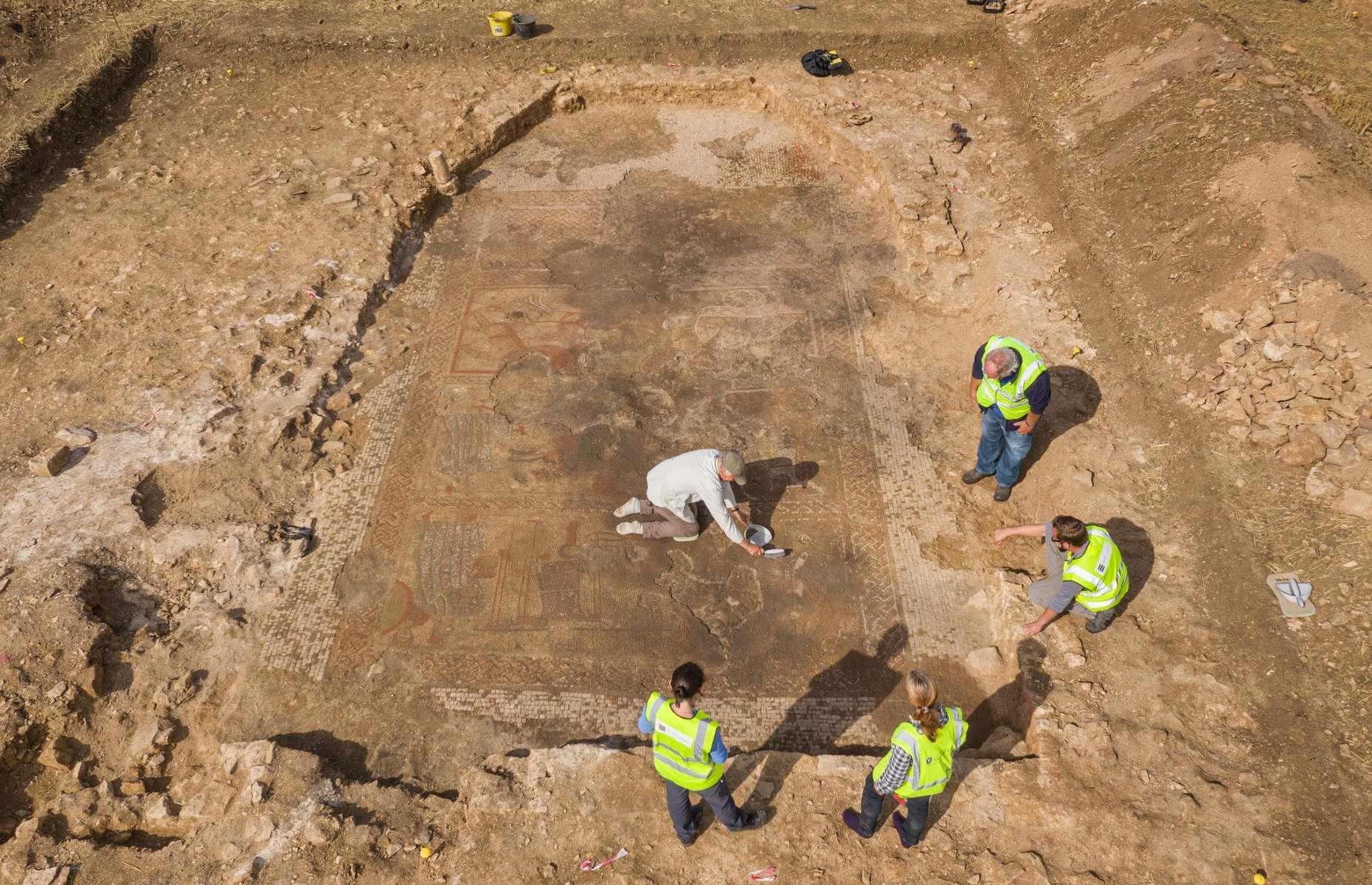
Roman mosaic, Rutland, England, UK
In November 2021, the team announced the discovery was in fact a rare Roman mosaic depicting scenes from Homer’s Iliad. Experts from Historic England have described the mosaic, which was part of a larger villa complex owned by a wealthy individual, as the first of its kind to be found in the UK.

Ice-age mammoths, Cotswolds, England, UK
At a gravel quarry near Swindon in the Cotswolds, the remains of five woolly mammoths, dating back to the last Ice Age, were unearthed in December 2021. While single examples of such creatures have been found before, to find five of the 200,000-year old skeletons in such pristine condition was “incredibly rare” according to evolutionary biologist Professor Ben Garrod. They were the subject of a documentary presented by David Attenborough (pictured).
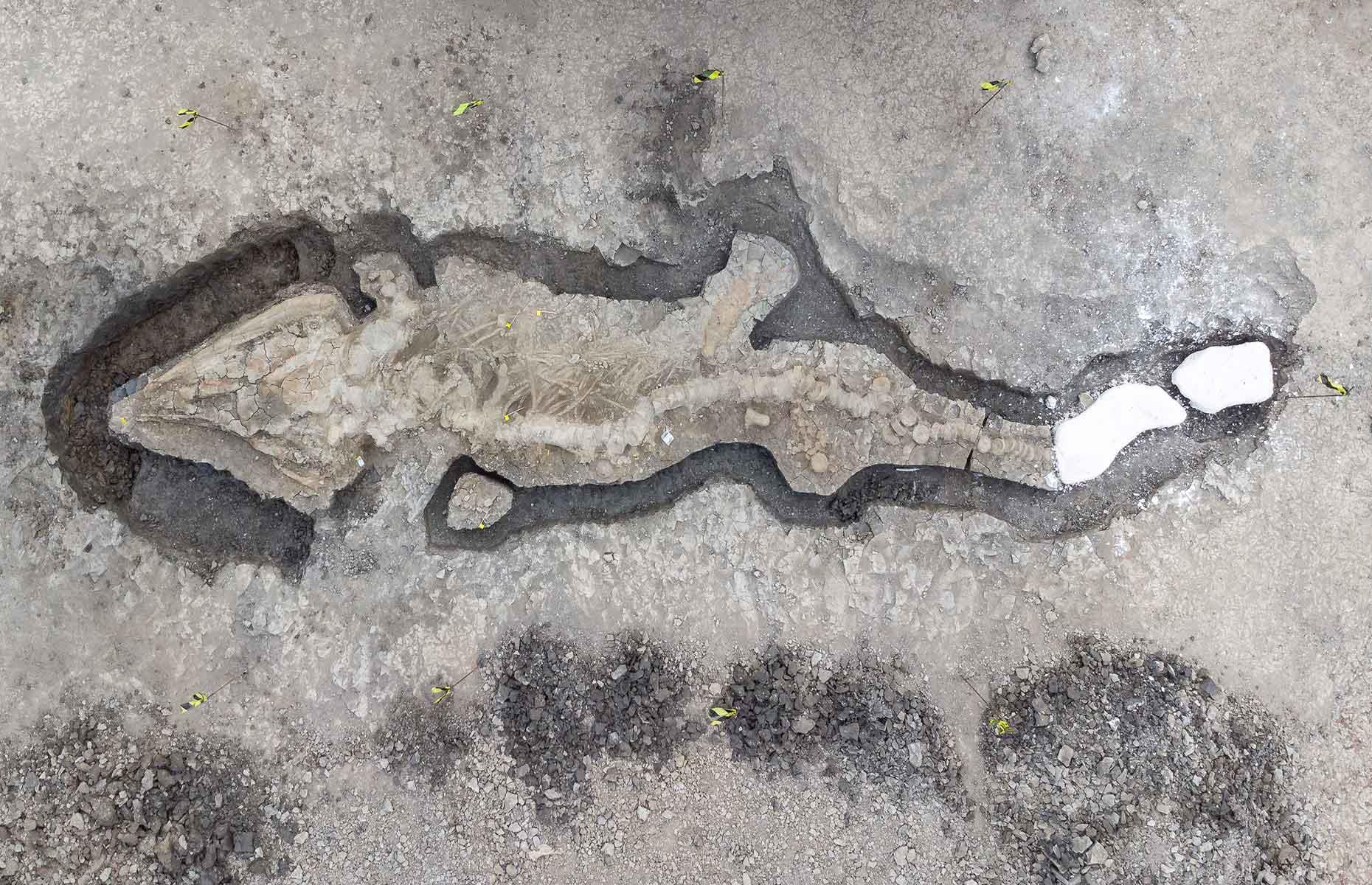
Sea dragon fossil, Rutland, England, UK
Another recent ancient discovery made in Rutland, England was the fossilised remains of an ichthyosaur, also known as a sea dragon. The impressive and well-preserved skeleton was first found in February 2021 during a routine draining of a lagoon at Rutland Water Nature Reserve, which is owned and run by Anglian Water. Not only is it the biggest and most complete skeleton of its kind found in the UK, scientists also believe it's the first of its species, known as Temnodontosaurus trigonodon, to be discovered in the country.
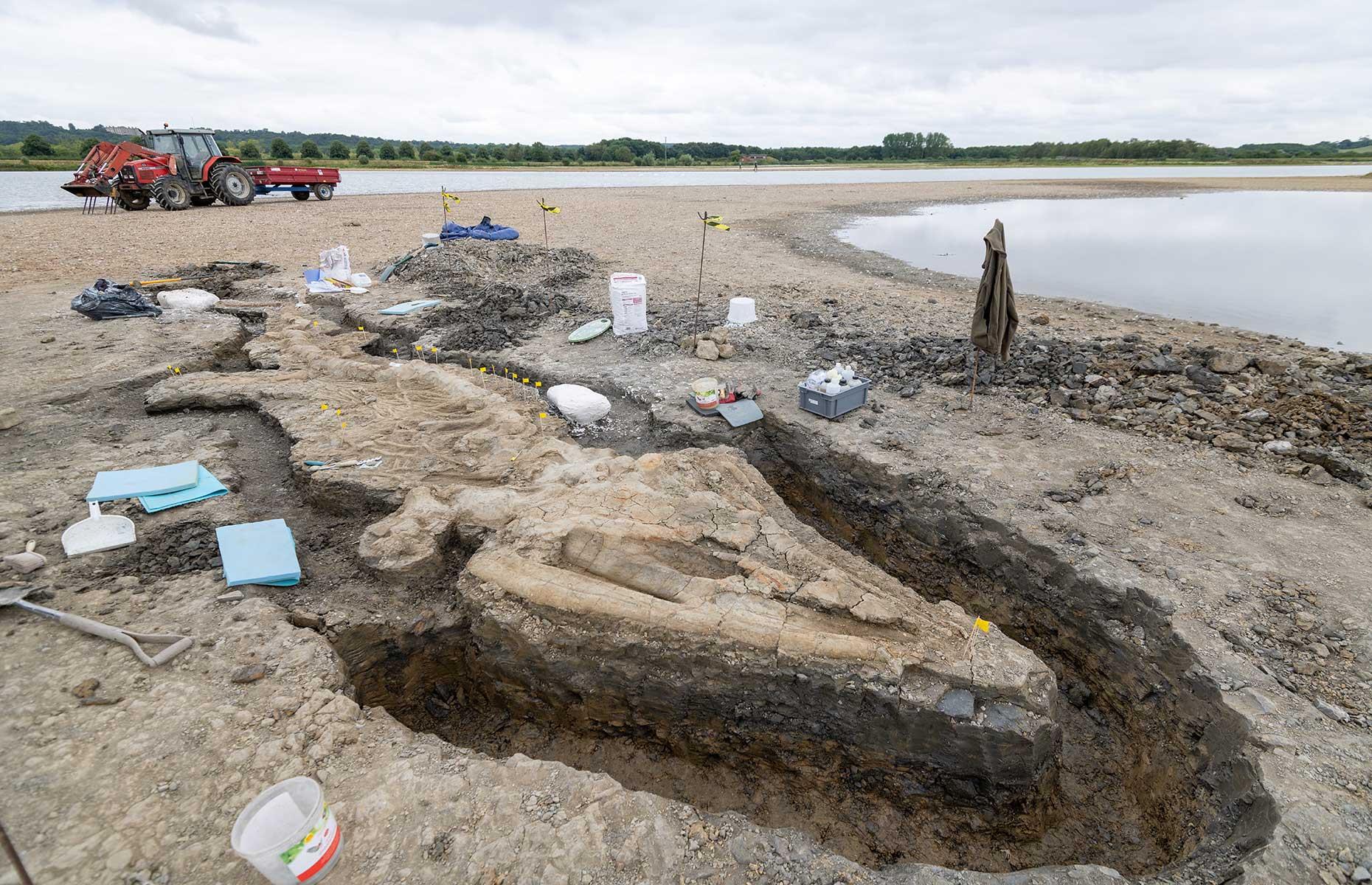
Sea dragon fossil, Rutland, England, UK
The sea dragon has been hailed as one of the UK's greatest fossil finds. After excavations in August and September 2021, the skeleton was revealed to measure around 33 feet (10m) in length and is thought to date back 180 million years. It's not the first ichthyosaur to be found here. In the 1970s, two much smaller and incomplete skeletons were uncovered, but the well-preserved nature of the most recent discovery makes it much more important.
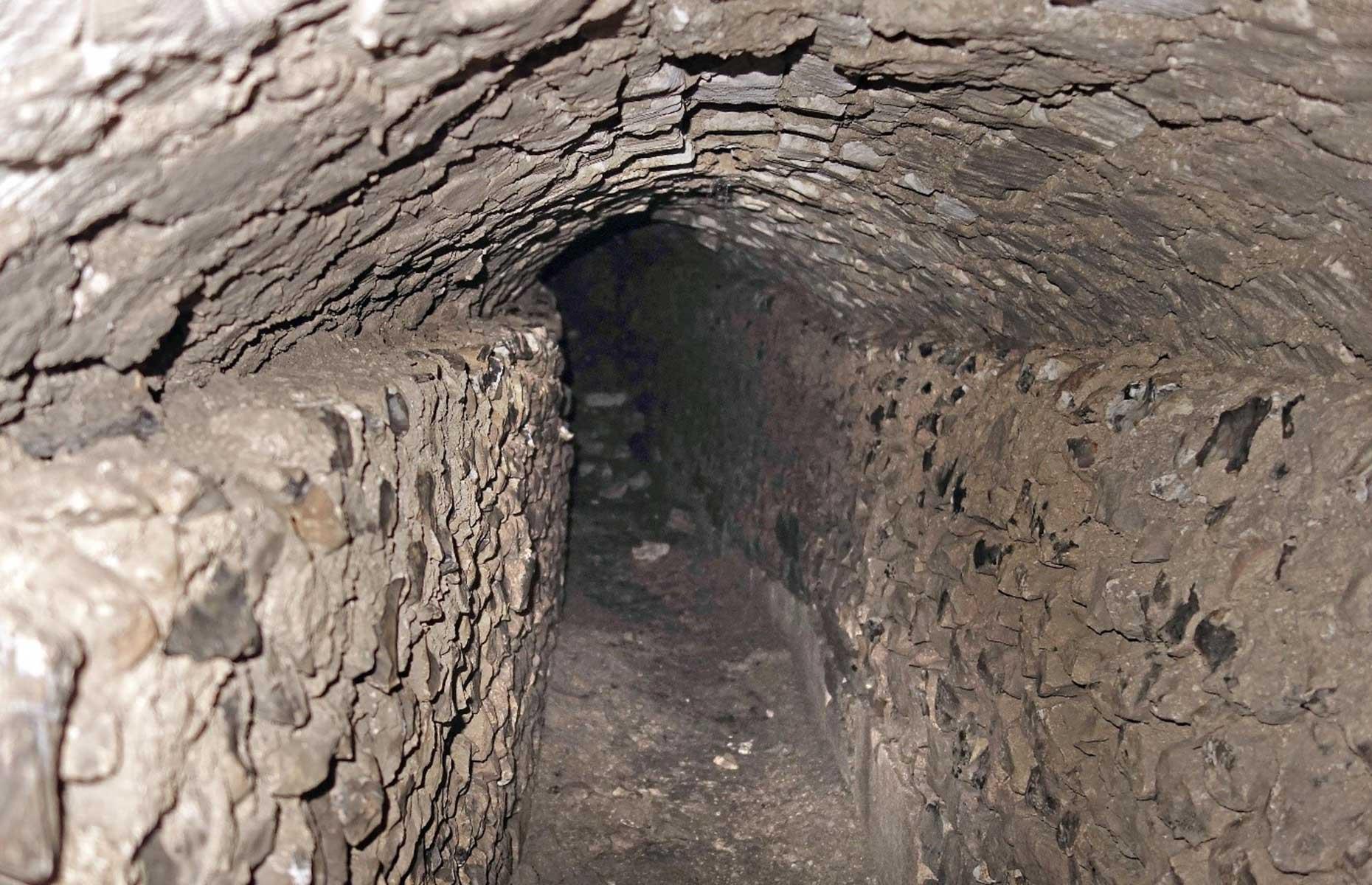
Medieval water tunnel, Winchester, England, UK
In August 2022 archaeologists and volunteers from the Hyde900 charity unearthed a medieval water tunnel, dating back to King Alfred the Great's reign. Located near Hyde Abbey, Alfred's final resting place, the 'extraordinary discovery' likely supplied water to the refectory, kitchens, infirmary of the abbey and latrines of the monks' dormitories.
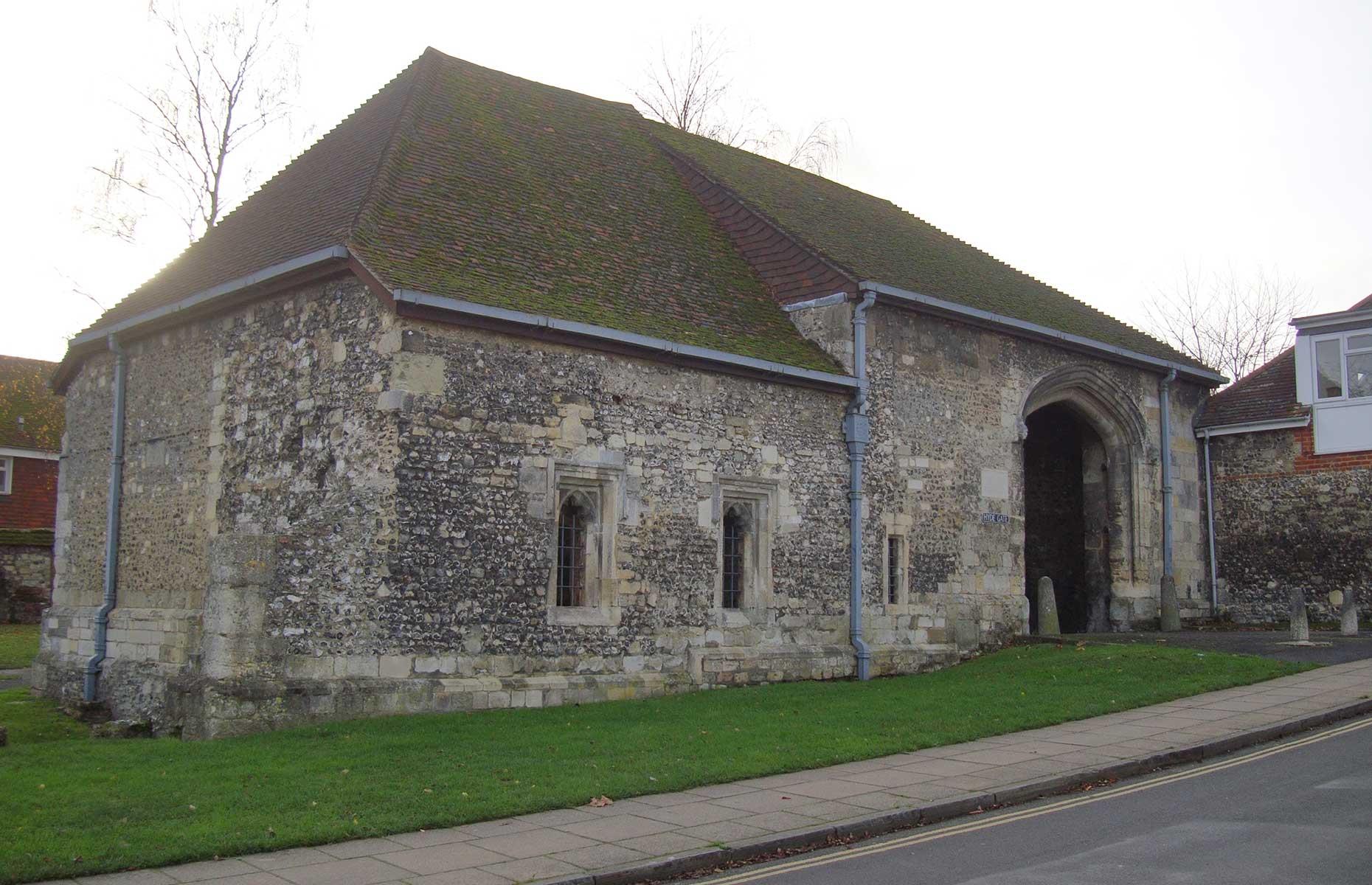
Medieval water tunnel, Winchester, England, UK
As well as locating the vaulted channel, the team identified Roman pottery shards, medieval tiles and window glass and bones. These were found in the uncovered remains of a two-storey building previously found in a garden in 2020, also close to Hyde Abbey (pictured).

Dinosaur footprints, Texas, USA
Following severe drought conditions in Texas, USA, in August 2022, huge dinosaur tracks were discovered in a dried up muddy riverbed at Dinosaur Valley State Park. Said to belong to an Acrocanthosaurus, a 15-foot (5m) tall, seven-tonne early cousin of the T-rex, the tracks are around 113 million years old. Another species, the Sauroposeidon, measuring 60 feet tall (18m) and weighing a whopping 44 tonnes, is also likely to be responsible for some of the footprints, according to experts. Although the park is famed for its dinosaur tracks, this is the first time these particular footprints have been seen.

A terrifying Thalassotitan fossil, Casablanca, Morocco
Scientists in Morocco have recently discovered a terrifying fossil which gives a look into what once swam at the bottom of our oceans. A cross between a Komodo dragon, great white shark, killer whale and T.Rex, the fossil was named Thalassotitan atrox, which means 'dreadful titan of the sea'. The ancient sea creature lived around 66 million years ago and measured 30 feet (9m) in length. The team from the University of Bristol, who found the fossil, believe that the creature spat out its prey’s bones, some of which they might still find near the fossil.
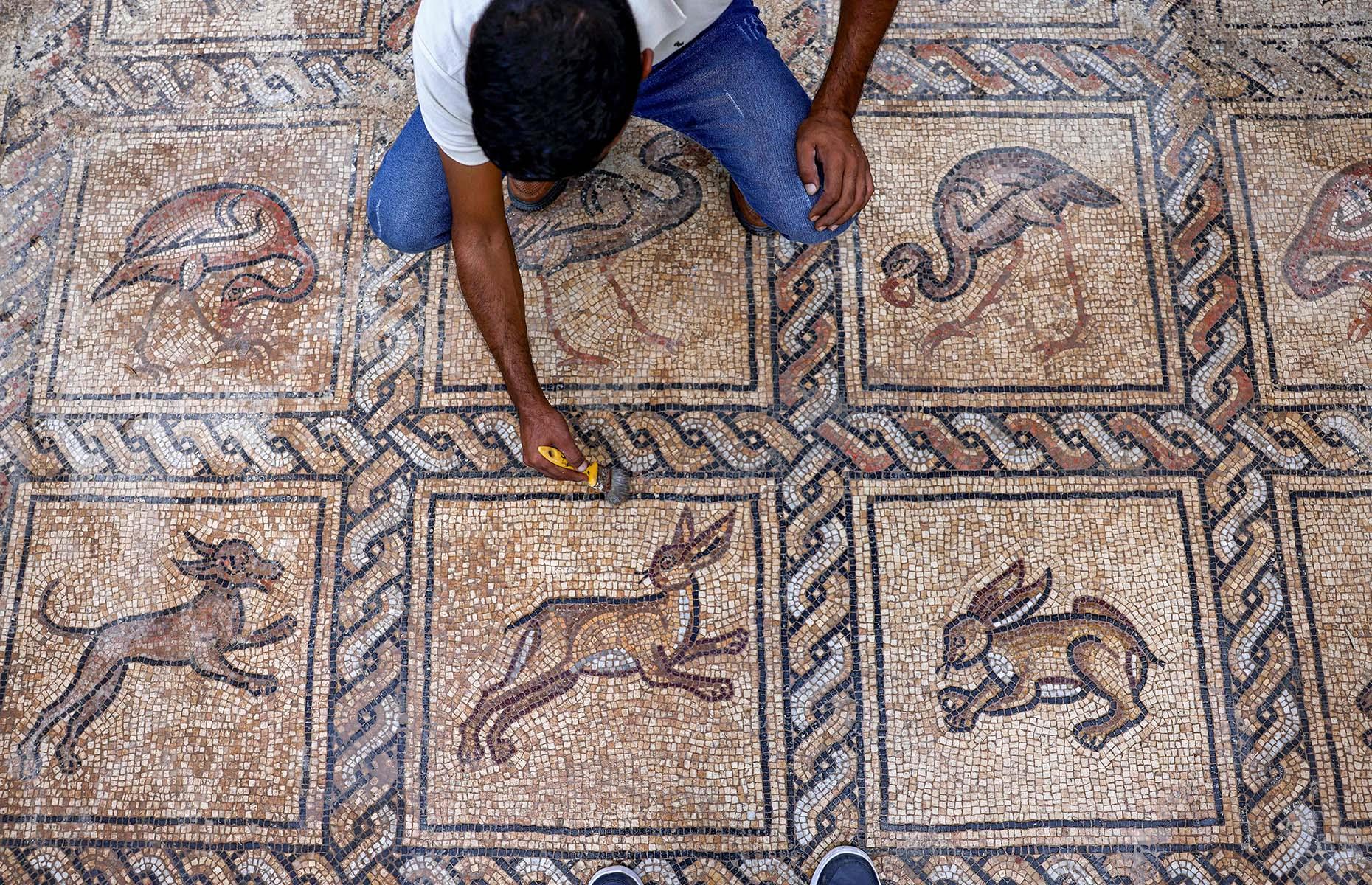
Byzantine floor mosaic, Gaza, Palestine
A farmer accidentally uncovered an intact Byzantine floor mosaic after trying to plant new trees in his Gaza orchard. The discovery happened six months ago when Salman al-Nabahin and his son Ahmad tried to figure out why the olive trees weren't taking root. While digging, Ahmad's axe hit something hard, and the pair realised it was an ornate mosaic, said to date from the fifth to the seventh century AD, depicting birds and other animals. The Palestinian Ministry of Tourism and Antiquities said: "The archaeological discovery is still in its early stages and we await to know more of the secrets and civilisation values."
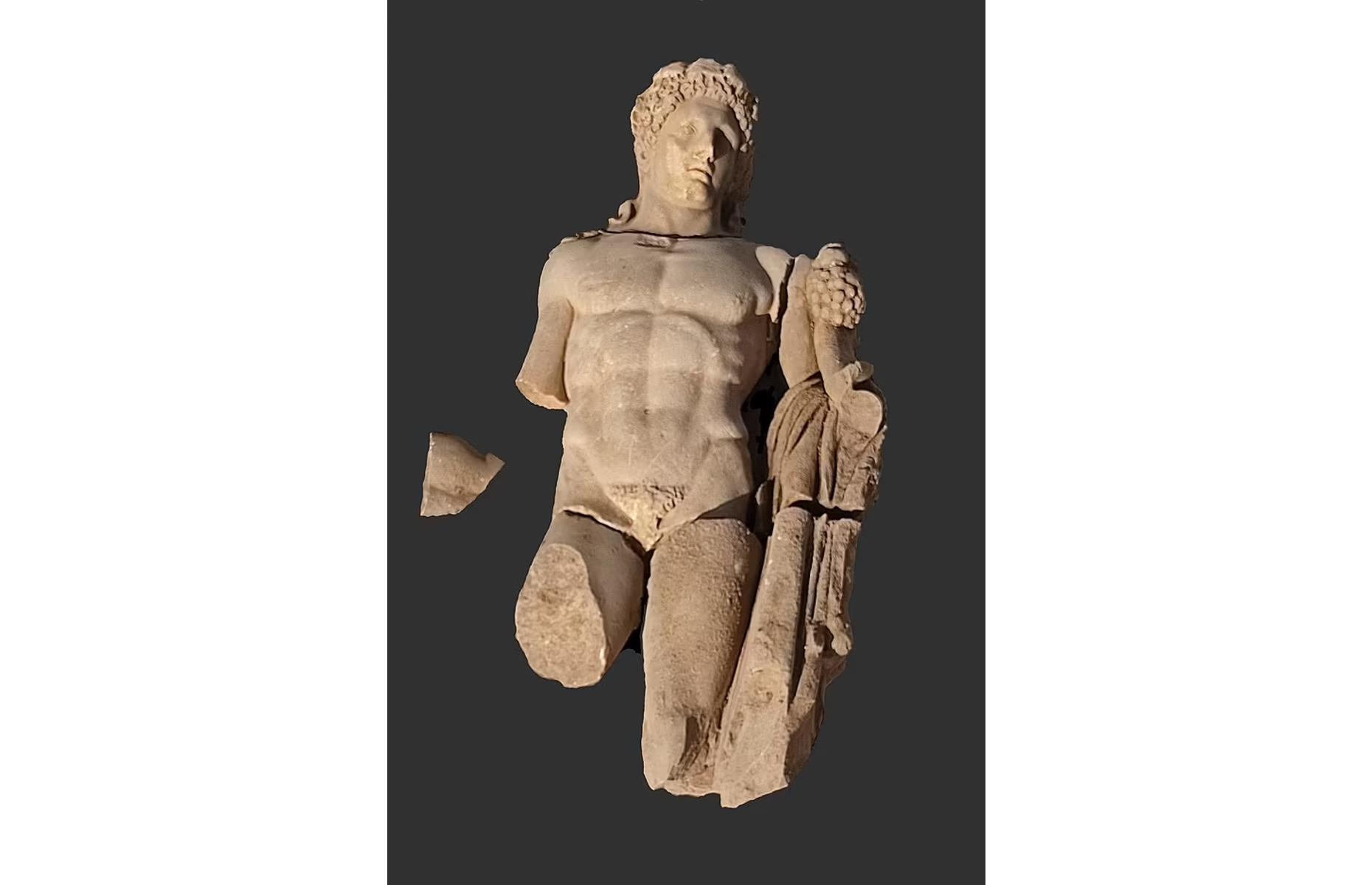
Hercules statue, Philippi, Greece
While excavating the ancient and abandoned city of Philippi, a team from the Aristotle University discovered a well-preserved stature of the mythical hero Hercules. The infamous figure from Greek and Roman myths was worshipped as a protector and a champion of the weak, often depicted holding a club and holding a lion skin cloak. The researchers believe that the almost 2,000-year-old statue was used to decorate a building, which dates back to the 8th or 9th century.
Find out what the Seven Wonders of the Ancient World would look like today
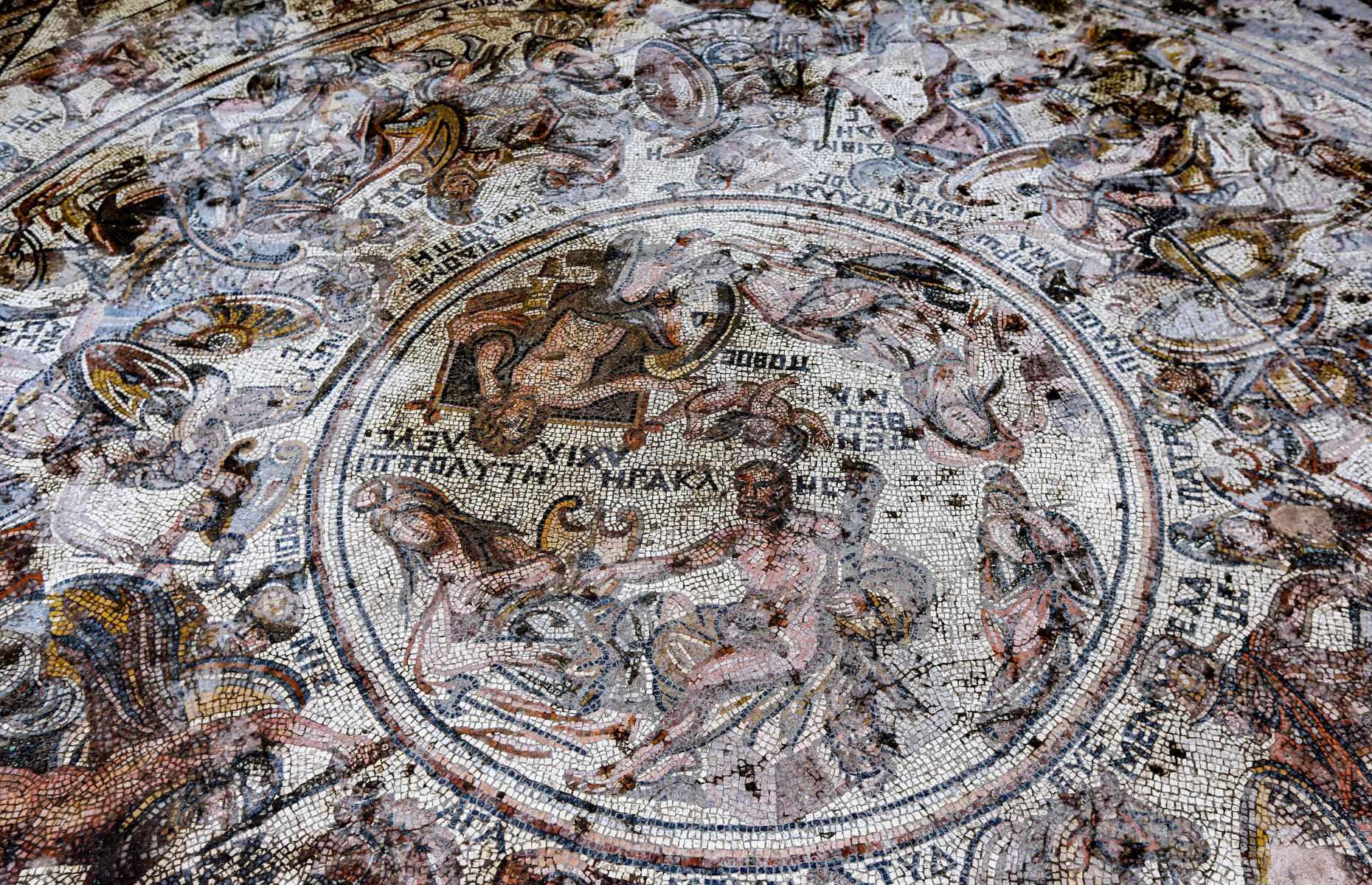
Trojan War Mosaic, Rastan, Syria
In October 2022, archaeologists found this 1,600-year-old mosaic in Rastan in northern Syria, which the government only seized back from rebels in 2018. Thought to be the floor of an ancient bathhouse, the unusually intact 1,300-square-foot (120 sqm) art piece depicts the Trojan War, a semi-mythical conflict from more than 2,000 years ago between the ancient Greeks and the walled city of Troy. Constructed in the Roman era, the mosaic shows soldiers with swords and shields alongside mythical Amazons said to have fought alongside the Trojans.

Megalithic dolmen, Cork, Ireland
A partially submerged structure thought to be an 18th-century 'folly' (decorative building) has now been identified instead as an ancient megalithic dolmen. Located in Cork Harbour, on the former estate of Rostellan Castle, the Carraig á Mhaistin stone was previously believed to be an ornamental monument built in the medieval style. But local archaeologist Michael Gibbons now believes he now has "conclusive evidence" that it's a prehistoric structure, with more likely concealed beneath the surface.

Assyrian reliefs, Nineveh, Iraq
Archaeologists have unearthed Assyrian marble reliefs dating back 2,700 years in Mosul, northern Iraq. The team were rebuilding the Mashki Gate (Gate of God), originally built around 700 BC (then Nineveh), reconstructed in the 1970s but destroyed by ISIS militants in 2016. The astonishingly rare find included seven slabs of marble decorated with ornate carvings of palm trees, pomegranates and Assyrian soldiers firing arrows, and was part of a previously hidden room in King Sennacherib's palace. Buried for millenia, their beautiful preservation means archaeologists can now dig deeper into the Neo-Assyrian Empire's history.
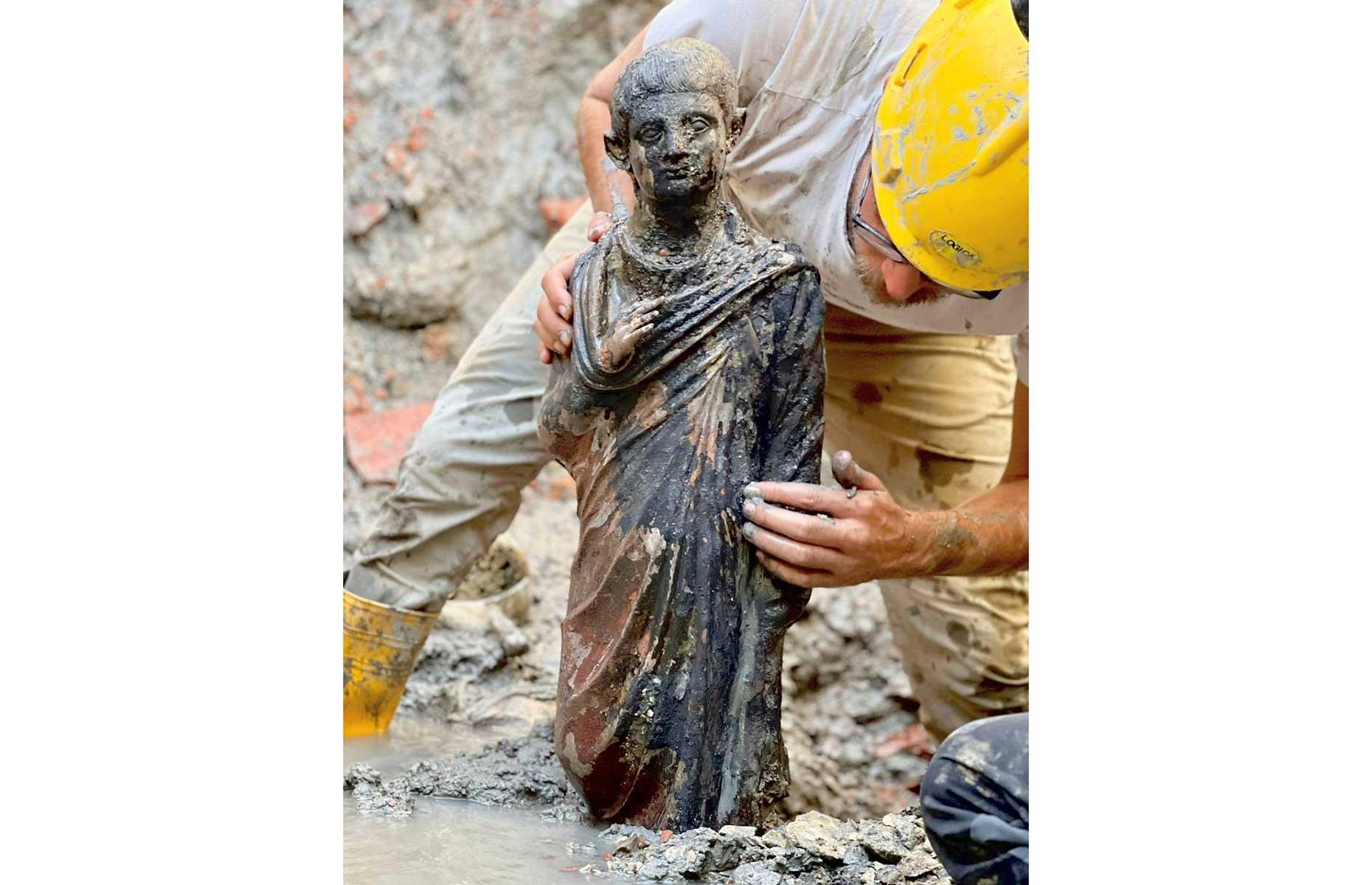
Ancient bronze statues, Tuscany, Italy
A hoard of 24 Etruscan and Roman bronze statues have been unearthed by archaeologists digging in an ancient religious sanctuary near the village of San Casciano dei Bagni. Dated between the second century BC and the first century AD, they depict gods and replicas of human organs, which had been tossed into the thermal waters by devotees hoping to be healed. According to a local professor, this significant find will "rewrite history", as it provides evidence that the relationship between Etruscans and Romans was closer than previously thought; the two peoples even prayed to deities together. There are plans to turn the site into an archaeological park and display the statues at a new museum.
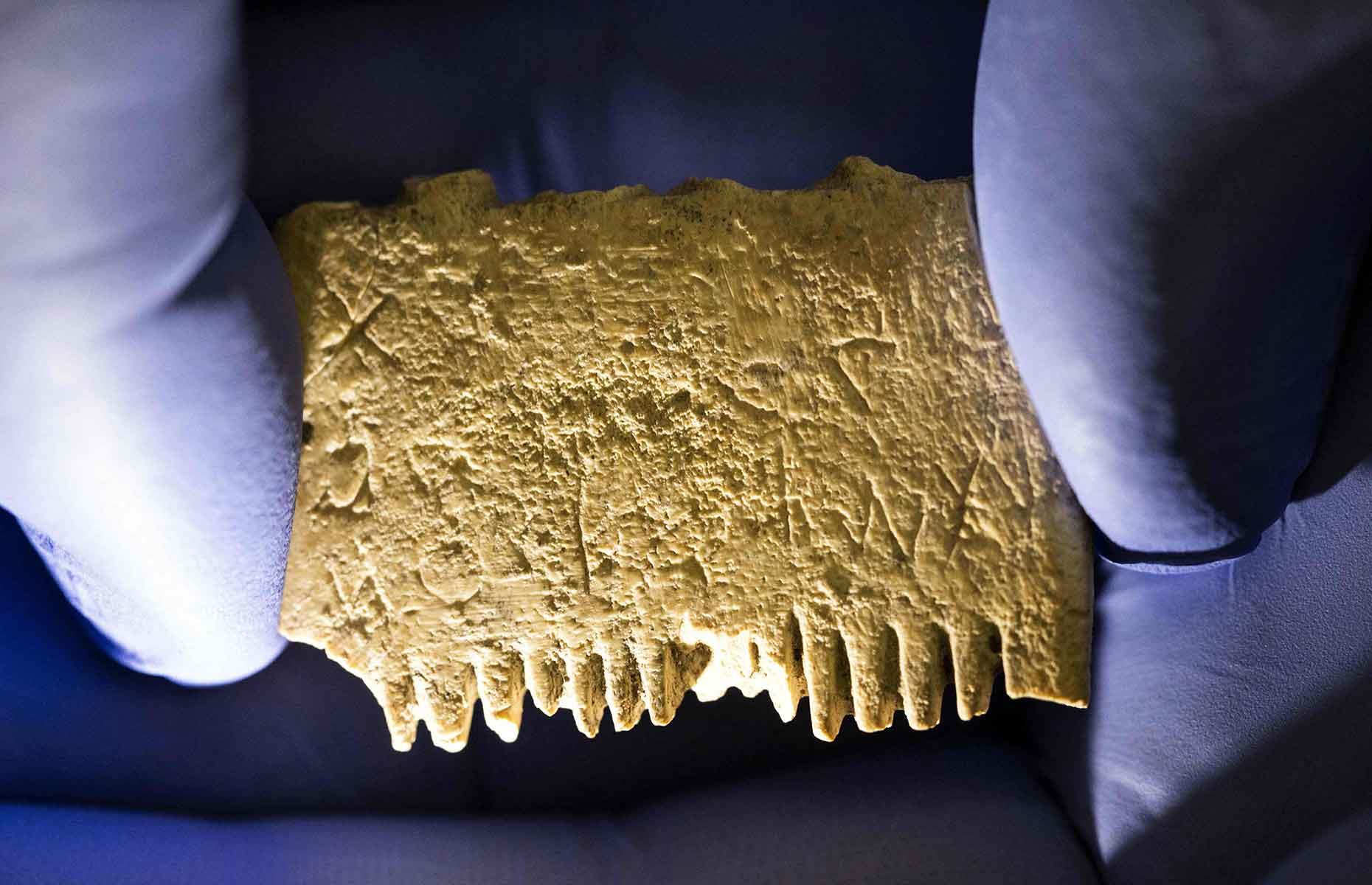
Canaanite comb, Lachish, Israel
The oldest known sentence written in the earliest alphabet has been discovered – on a head-lice comb. While the 3.5cm-long tool was discovered in 2017, its engravings were only spotted in 2021; the text reads "May this tusk root out the lice of the hair and beard". The find was excavated in Lachish, an ancient Canaanite city state, and possibly dates to 1700 BC. Archaeologists say this was a luxury item as most others were simply made from wood or bone.

Hand of Irulegi, Navarre, Spain
In 2021, archaeologists unearthed this 2,100-year-old bronze relic in Navarre, northern Spain. The Hand of Irulegi once belonged to the Vascones, a late-Iron Age tribe, and was most likely hung over a door for good luck. During its restoration in 2022, a four-line inscription was found etched into the hand – the words are now believed to be the earliest ever written in the Basque language. Before the discovery, it was thought the Vascones were mostly illiterate.
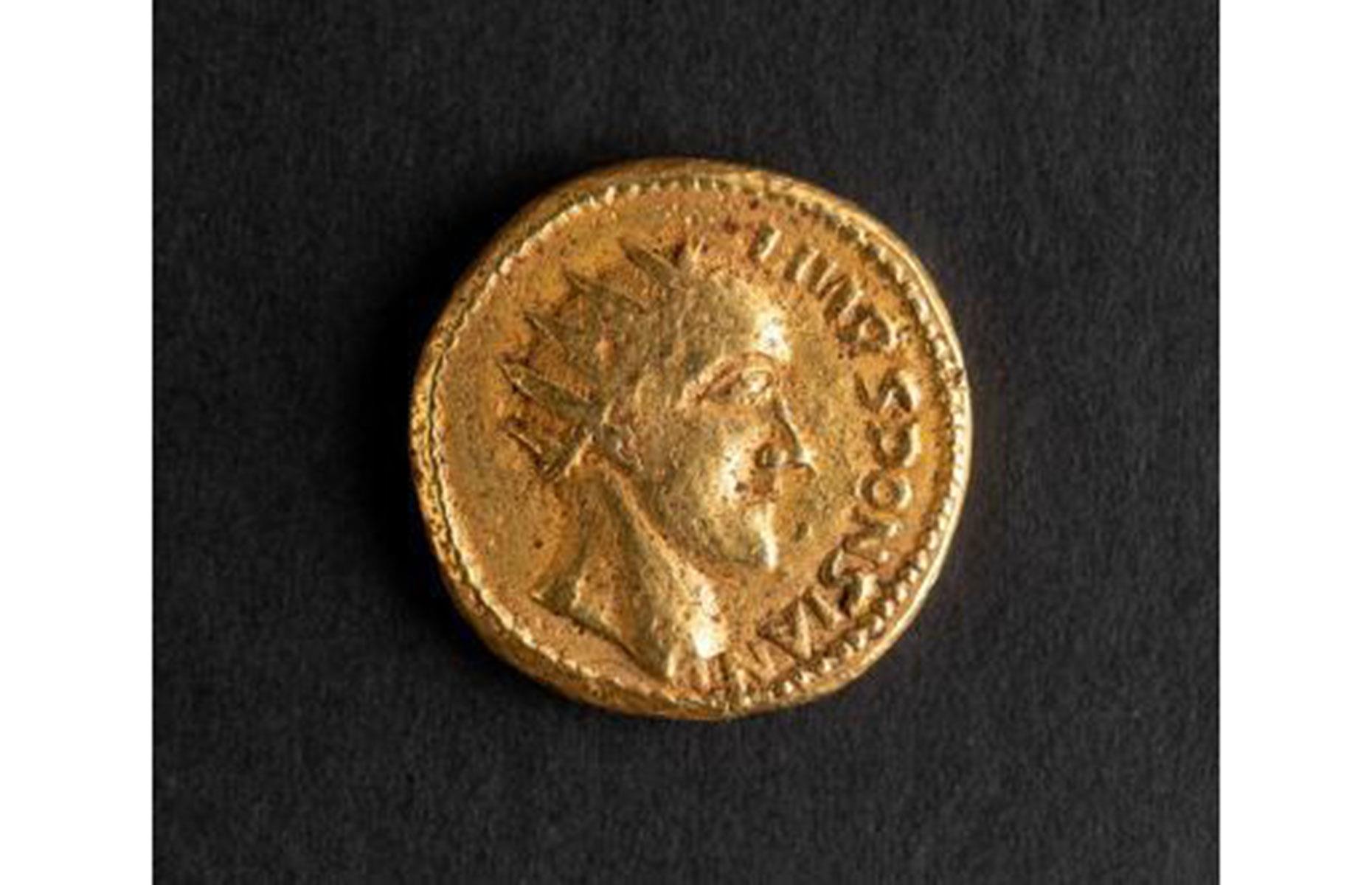
Sponsian coin, Transylvania, Romania
History doesn't change very often (because, well, it's already happened) but a 4th-century Roman coin has just rewritten a brief period in Europe's past. Discovered in Romania 300 years ago, the coin was always considered a fake as it dated from the reign of Emperor Sponsian – an emperor long dismissed by historians as a fictional character. Now, after new analysis, scientists say scratch marks on the coin prove its validity, and therefore that of the emperor that adorns it. Experts must now reckon with a brand-new Roman emperor, though there is no suggestion he ever ruled centrally from Rome.

Roman barn conversion, England, UK
When a grand Roman villa complex was unearthed in Rutland in 2021, archaeologists revealed a rare mosaic depicting a scene from Homer's epic, Iliad. And in 2022, further excavations at the site uncovered one of Britain's earliest barn conversions. Experts believe the timber-built barn was converted to stone in the 3rd or 4th century AD to provide space for a Roman bathing suite (pictured), complete with a hot steam room, a warm room, a cold plunge pool and underfloor heating, while the other end was likely retained for agricultural or craft work. Talk about the life of luxury...
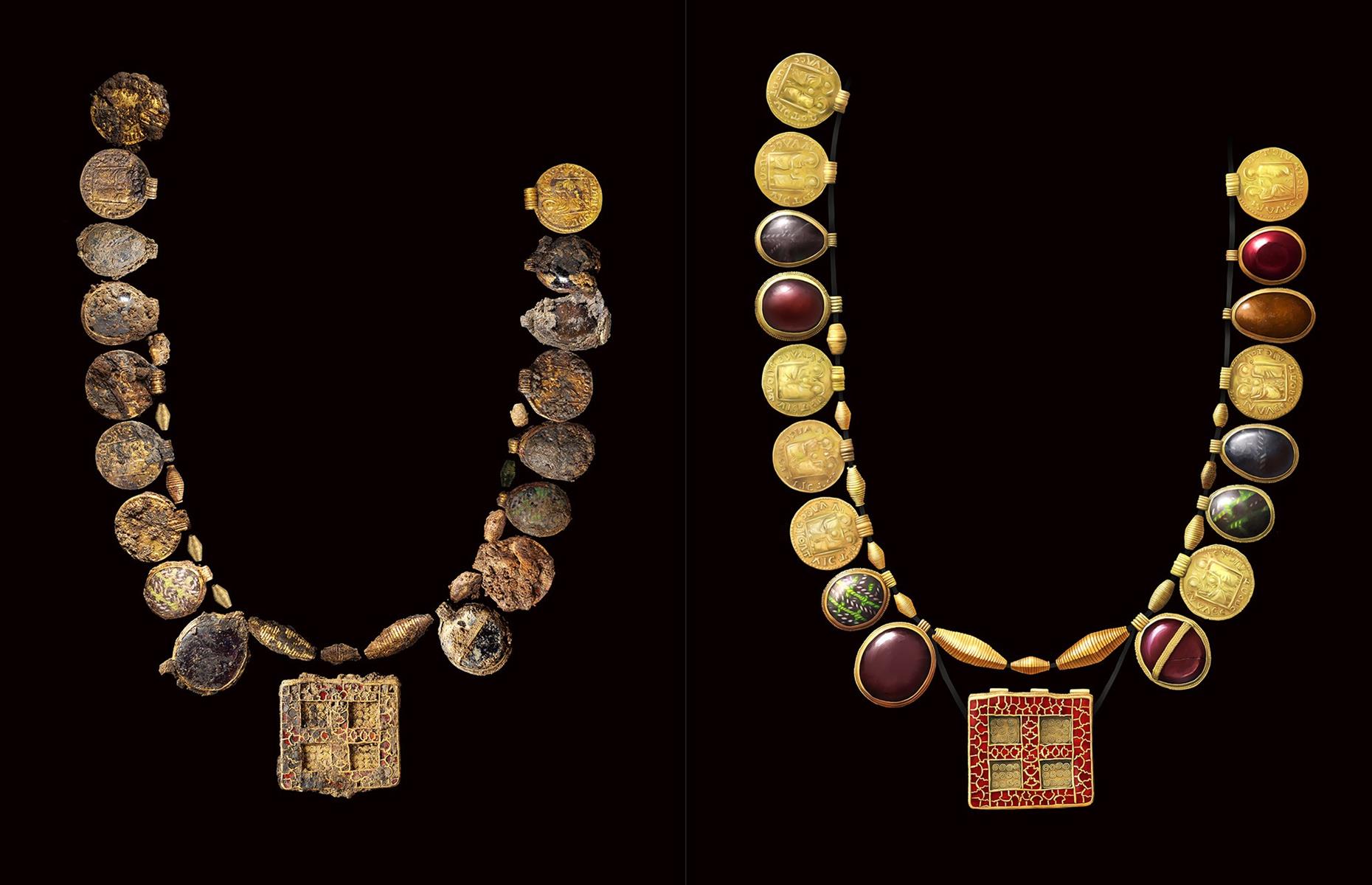
Medieval necklace, England, UK
In 2022, archaeologists in the UK uncovered a "once-in-a-lifetime" find – a grand medieval necklace adorned with Roman coins, gold, garnets and semi-precious stones, with an intricate rectangular cross as its centrepiece. A burial item, likely draped around the neck of a devout, high-status woman (an abbess perhaps, or a minor royal), the ornament was plucked from the ground in the village of Harpole ahead of a proposed housing development, where it had lain for more than 1,350 years. Already nicknamed 'the Harpole Treasure', the necklace is much more extravagant than any other find of its kind, better-made and better-preserved than the Saxon necklaces found in the British Museum.
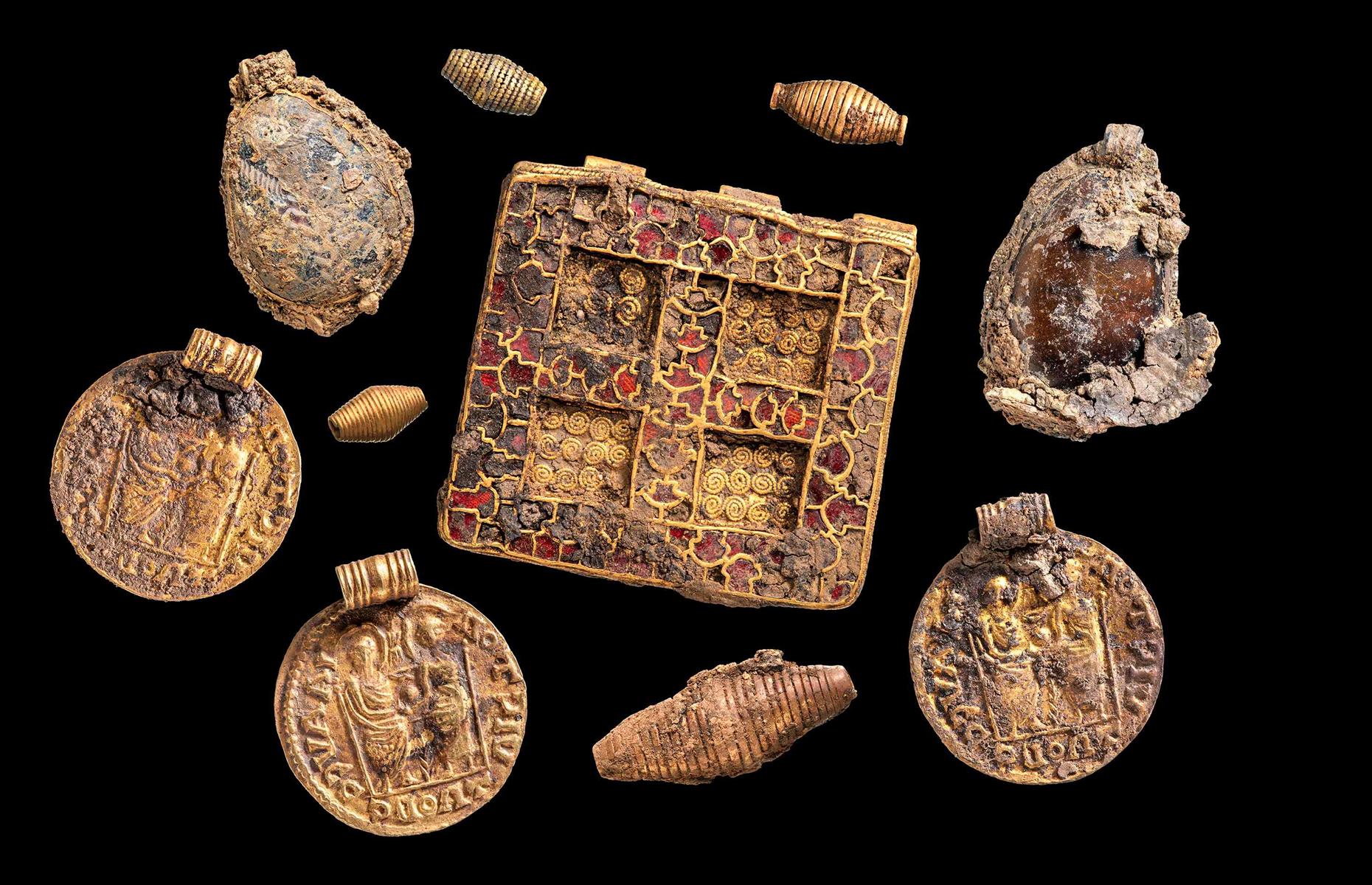
Medieval necklace, England, UK
"When the first glints of gold started to emerge from the soil we knew this was something significant," said Levente-Bence Balazs, lead excavator of the Museum of London Archaeology team that unearthed the treasure, "but we didn't realise quite how special it was going to be." Fragments of tooth enamel are all that remain of the necklace's wearer, though decorated pots and an elaborate, silver-cast cross found at the site also speak to her importance. Neither can compare with the necklace, uncovered on 11 April 2022 but only made public on 6 December that same year, and its 30 beads and gemstones encrusted with still-sparkling gold.
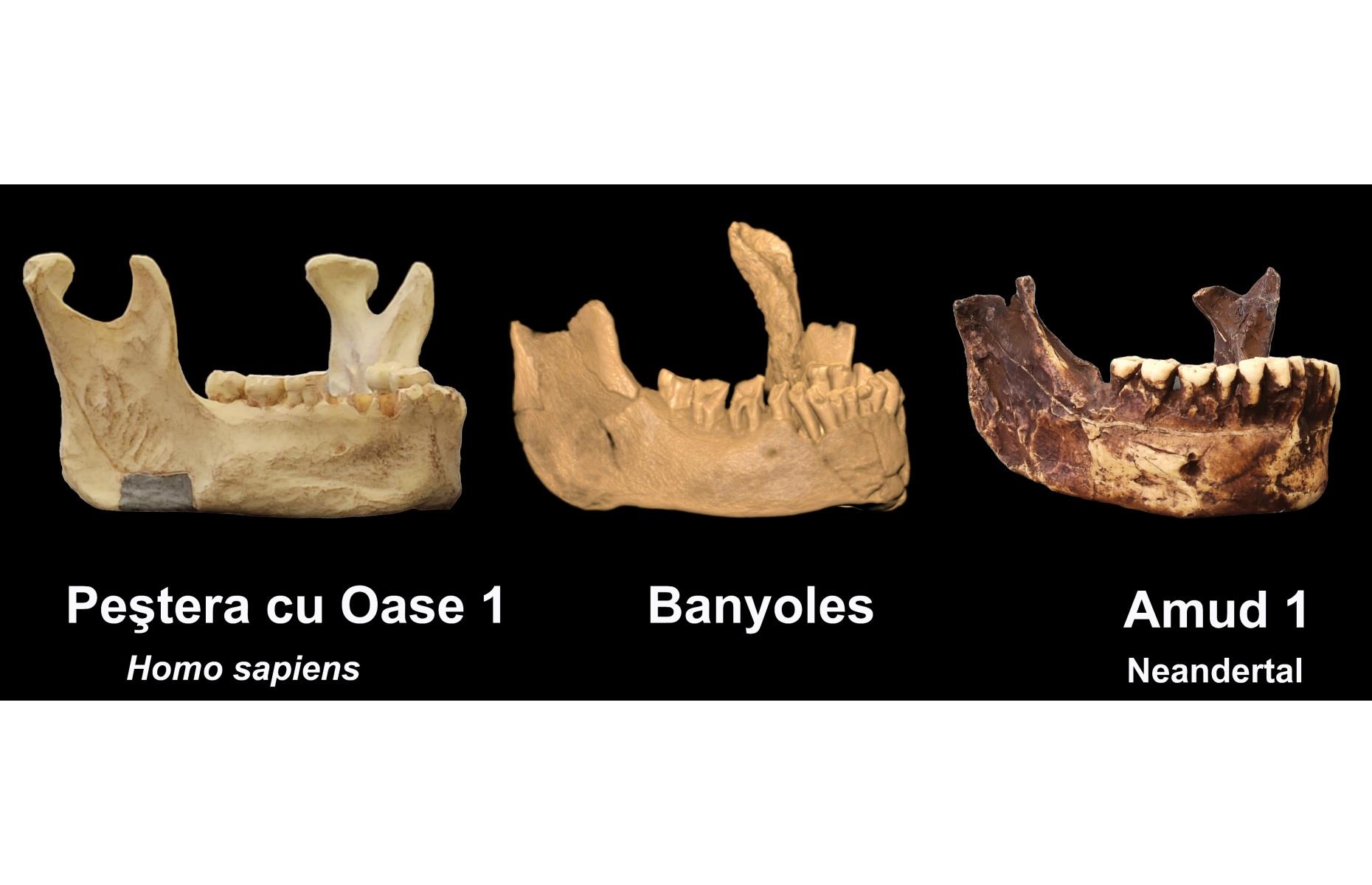
Prehistoric jawbone, Spain
In 1887, one of the earliest human fossils ever found was unearthed in a quarry near the Spanish town of Banyoles, and was quickly categorised as the jawbone of a Neanderthal (or Neandertal) – an extinct human subspecies that died out 40,000 years ago. In 2022, groundbreaking new analysis by researchers at Binghamton University, New York suggests that the frequently-studied bone might instead mark the oldest known presence of Homo sapiens in Europe. The team found it "shared no distinct Neanderthal traits", and could place modern humans in Europe up to 65,000 years ago. One mystery remains, as the bone lacks one crucial Homo sapiens trait: a chin.

Crocodile heads, Egypt
Archaeologists studying two tombs in the el-Assasif necropolis in Luxor (dating roughly to 1550-525 BC) have discovered nine crocodile heads wrapped in fabric, although they were not mummified nor given any other treatment for preservation. As a result, only skull and jawbone fragments have survived, which scientists have confirmed belong to a species native to freshwater habitats in Africa. Ancient Egyptians worshipped crocodiles in the form of the god Sobek, who was associated with pharaonic power, military prowess and fertility.
Now check out the oldest man-made structures still in use today

Assorted ancient relics, Spain
At the end of 2022, after receiving a tipoff concerning skeletal remains, Spanish police raided two homes in the Alicante province. What they found was astonishing: a (probably illegal) treasure trove of 350 ancient artefacts, ranging from 5,000-year-old bone fragments to Phoenican pottery. They're currently in a local archaeological museum while the investigation is underway. One of the suspects claimed the items were inherited from a deceased relative, who kept intriguing journals that pinpoint where the items were dug up. These handwritten notes could lead to the discovery of as-yet-unknown ancient sites in Alicante...
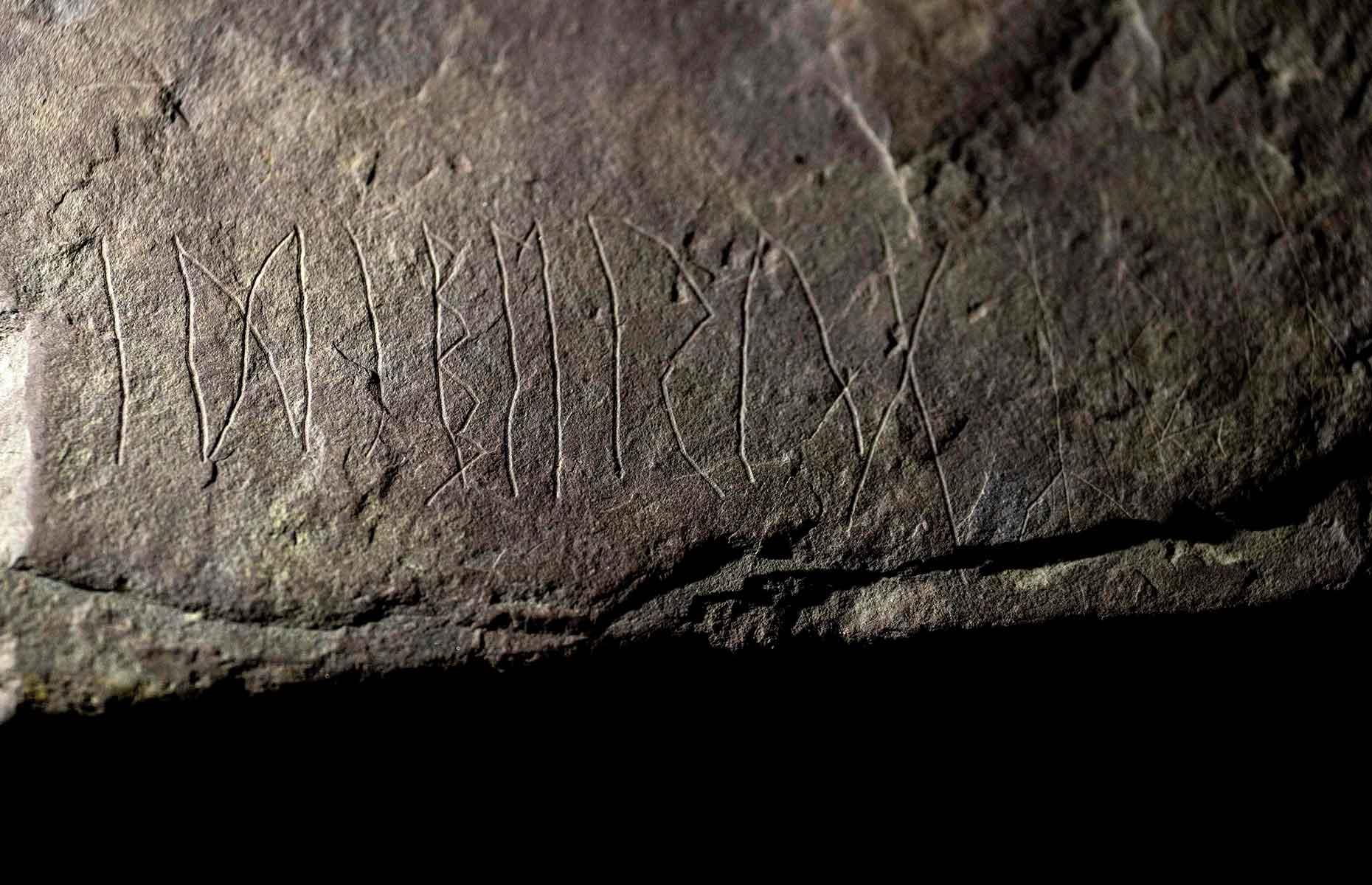
World's oldest runestone, Norway
While excavating an ancient grave near Tyrifjord, west of Oslo, archaeologists in Norway discovered a 2,000-year-old runestone – now thought to be the world's oldest. Some of the runes – an ancient language used in northern Europe until the adoption of the Latin alphabet – may read a person's name, and was described by Oslo's Museum of Cultural History as "among the oldest runic inscriptions ever found".
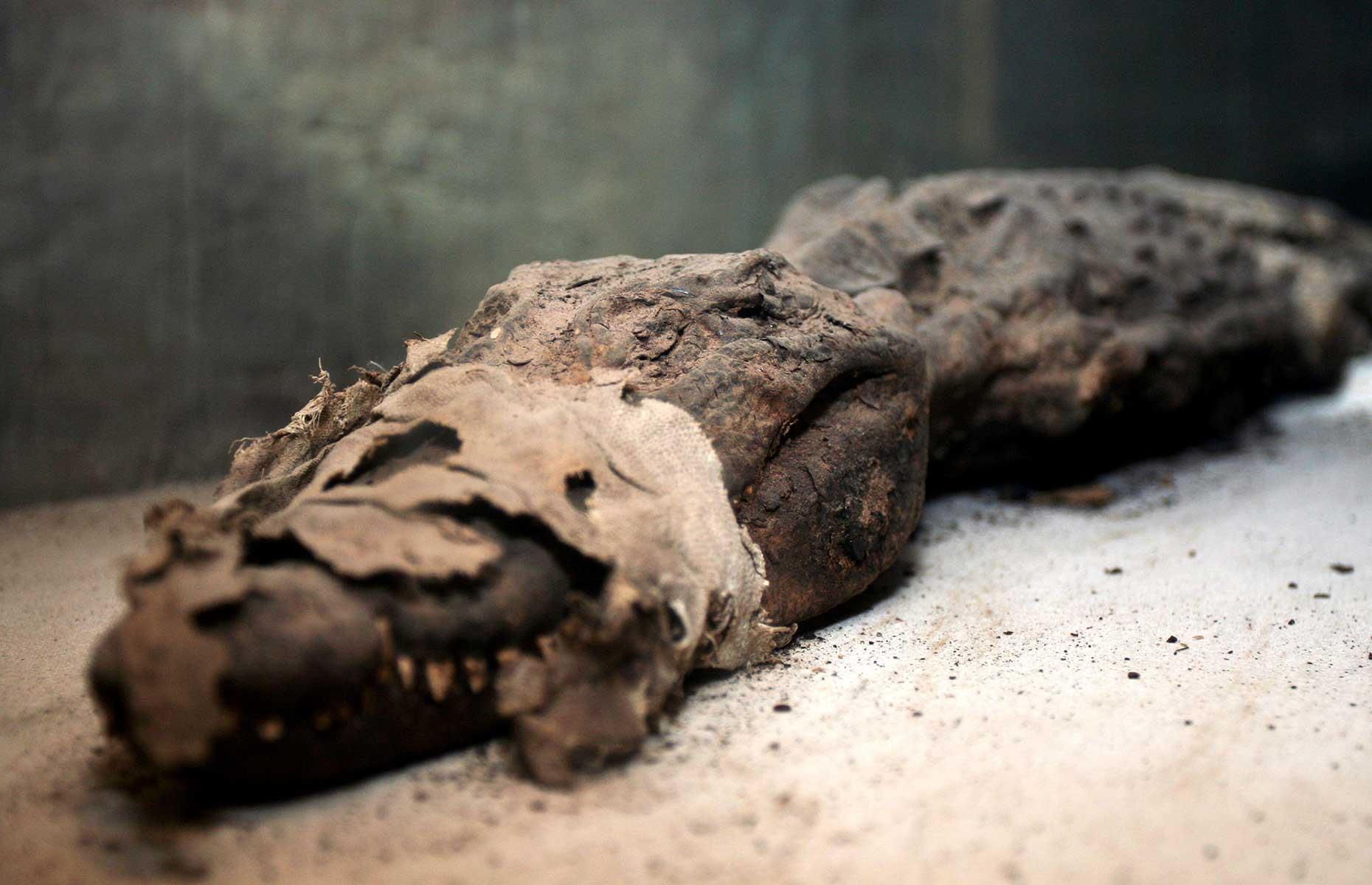
Ancient mummified crocodiles, Egypt
In 2019, archaeologists digging at the Qubbat al-Hawā burial site in southern Egypt unearthed 10 mummified crocodiles, and a recent study has finally confirmed these ancient reptiles date back over 2,300 years to the pre-Ptolemaic era (i.e. before 304 BC). Rather uniquely, they were found in a well-preserved condition, with their sizes ranging from six to 11 feet (1.8-3.5m) long. Pictured here is another mummified crocodile previously found in Egypt.
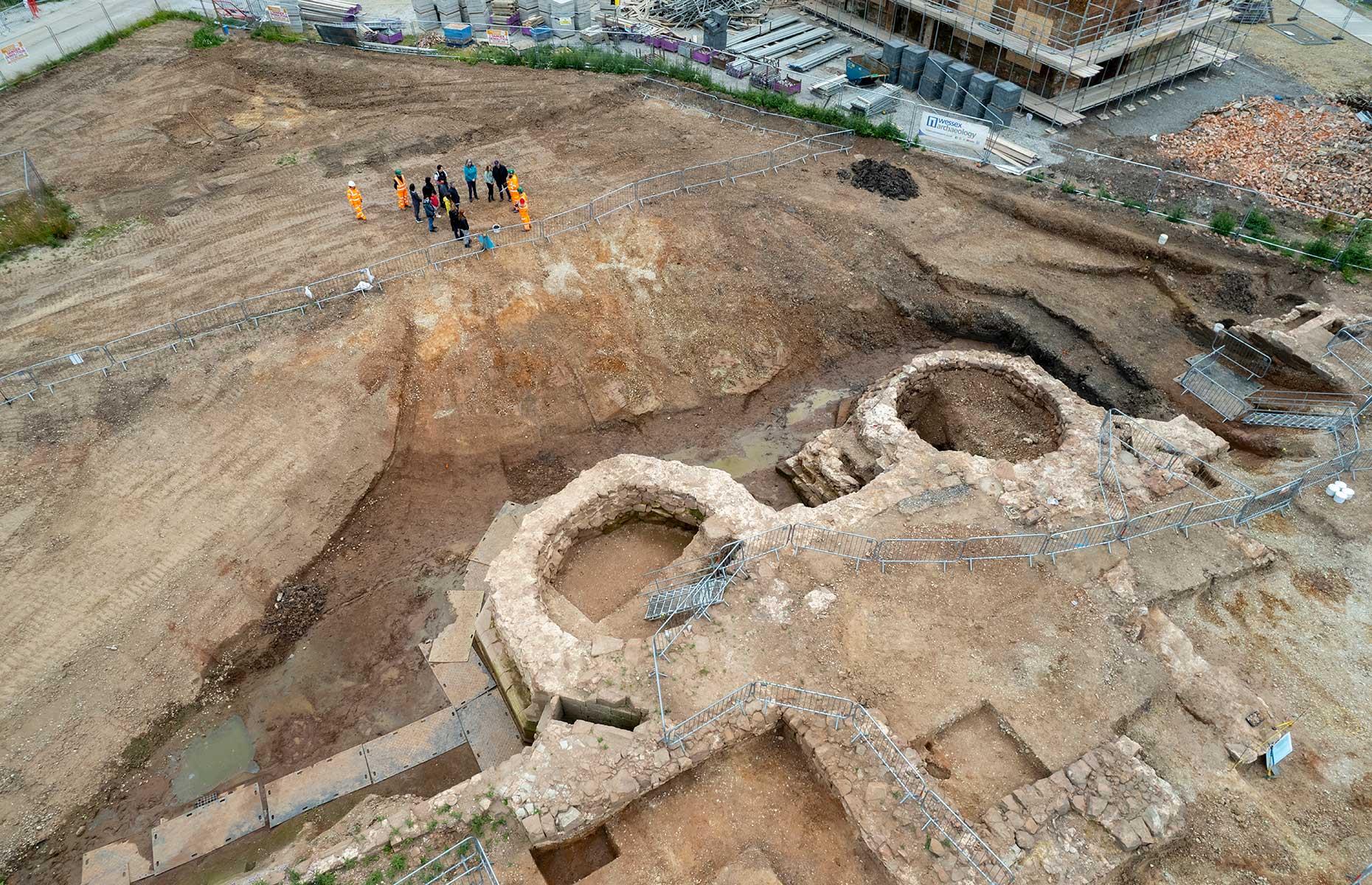
Medieval gatehouse, Warwickshire, England, UK
Around 200 pistol and musket ball marks were spotted on a medieval gatehouse at Coleshill Manor in Warwickshire, in England's West Midlands region. The 13th- or 14th-century gatehouse was discovered in 2021 by archaeologists working on a HS2 site, where a new high-speed railway is under construction. Upon closer inspection, the startling marks – which aren't written about in any historical records – were later revealed. Experts believe they date from 1642, and could show the first skirmish of the English Civil War: although it's currently believed that nearby Curdworth Bridge was the site of the opening battle, there is a theory that Parliamentarian forces shot at this property belonging to their enemy, the Royalists, on their way to Curdworth.
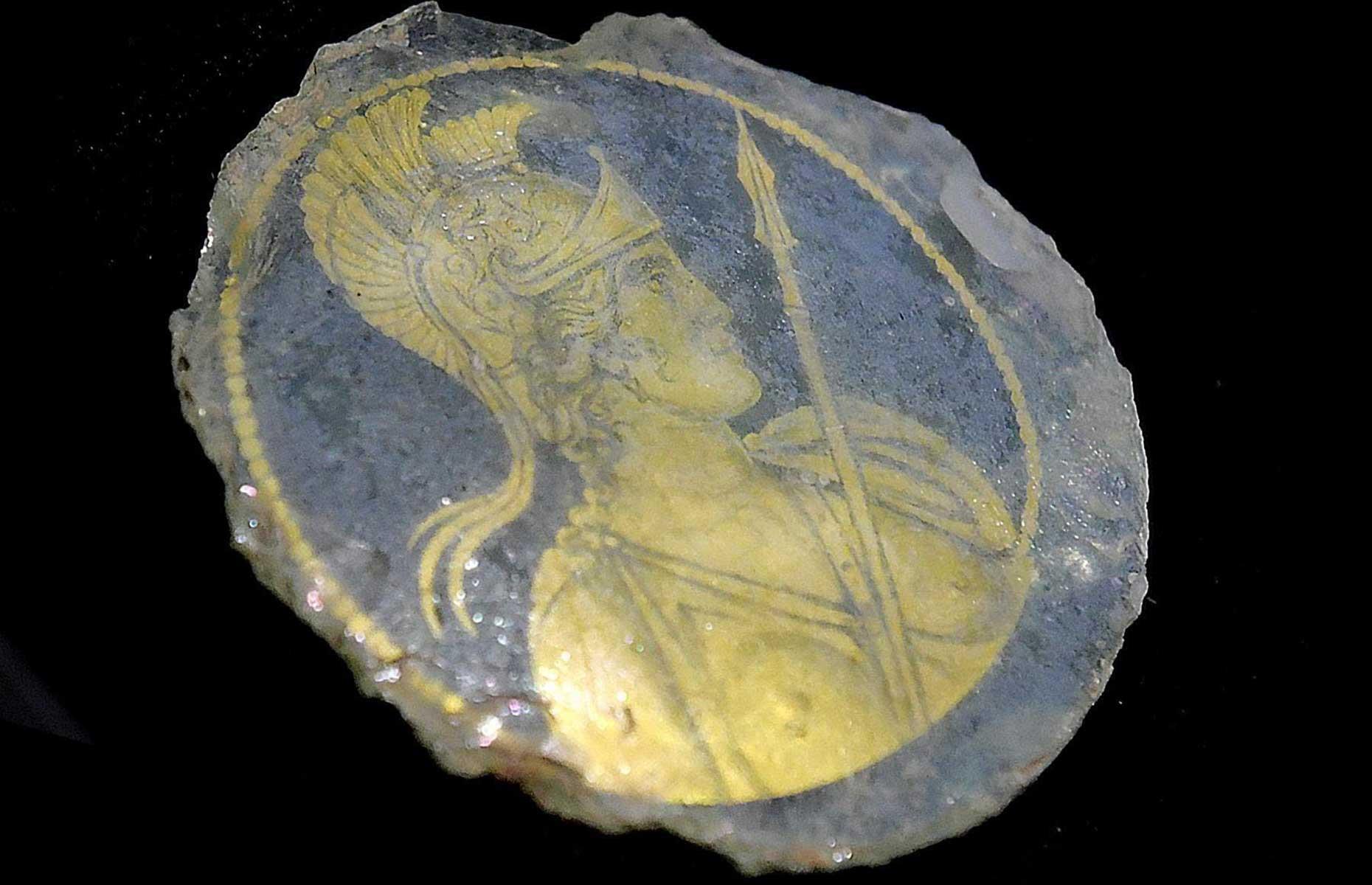
Rare golden glass fragment, Rome, Italy
During construction of a new metro station in Rome, workers discovered this unique golden glass fragment. Dating back to the fourth century AD, the rare find depicts Roma (the goddess who personified ancient Rome) and may have once formed the bottom of a drinking glass. It’s the first artefact of its kind ever found, with the use of gold leaf suggesting it was a luxury item. When the new metro station opens in 2024, it'll also house a small museum displaying the fragment alongside other artefacts found nearby.
Now check out the oldest man-made structures still in use today
More for You
Michael Cohen was Trump’s consummate inside man. Now, friends say he’s on the stand and at risk
Netflix's New Releases Coming in May 2024
Trainers Say This Move Will Strengthen Your Core Like None Other
Things that harm happiness in marriage the most
US $200 Million F-22s Show Off Their Aggressive Design During Crazy Takeoff
Golfing, gardening may be linked to ALS risk
Trump awarded 36 million more Trump Media shares worth $1.6 billion after hitting price benchmarks
What's cheaper, EV or gas? This scholar crunched the numbers
Romanian Deadlifts Are the Key to Better Glute Workouts - Here's How to Do Them
Report: Hurricanes pull extension offer for HC Rod Brind'Amour
The biggest new TV show every year since the '50s
14 of Jennifer Lopez’s Best Athleisure Looks
Chuck Norris: His Best Roles Through The Years
US Genius Invention to Fight Massive Forest Fires From The Sky
Joe Biden calls allies India and Japan ‘xenophobic’ and says that’s why their economies are stalling
The rise and fall of Peloton, from pandemic-era success story to its stock hitting a record low
12 things that will surprise you at European restaurants
The longest-running shows in TV history
Apron Belly: How to Reduce Stomach Sagging
Witness says Alaska plane that crashed had smoke coming from engine after takeoff, NTSB finds